
January 2025 Unique biology Precision therapeutics Broad impact NASDAQ LISTED FHTX Exhibit 99.2

| Forward Looking Statements 2 This presentation contains forward-looking statements that are based on management's beliefs and assumptions and on information currently available to management. All statements other than statements of historical facts contained in this presentation are forward- looking statements. In some cases, you can identify forward-looking statements by terms such as “could,” “may,” “might,” “will,” “likely,” “anticipates,” “intends,” “plans,” “seeks,” “believes,” “estimates,” “expects,” “continues,” “projects” or the negative of these terms or other similar expressions, although not all forward-looking statements contain these words. Forward-looking statements include, but are not limited to, statements concerning: the potential outcomes from our collaboration agreement with Lilly; the initiation, timing, progress and results of our research and development programs and pre-clinical studies and clinical trials, including with respect to our Phase 1 dose escalation trial of FHD-909 with Lilly; our ability to advance product candidates that we may develop and to successfully complete preclinical and clinical studies; our ability to leverage our initial programs to develop additional product candidates using our Gene Traffic Control Platform®; the impact of exogeneous factors, including macroeconomic and geopolitical circumstances, on our and our collaborators’ business operations, including our research and development programs and pre-clinical studies; developments related to our competitors and our industry; our ability to expand the target populations of our programs and the availability of patients for clinical testing; our ability to obtain regulatory approval for FHD-909 and any future product candidates from the FDA and other regulatory authorities; our ability to identify and enter into future license agreements and collaborations; our ability to continue to rely on our CDMOs and CROs for our manufacturing and research needs; regulatory developments in the United States and foreign countries; our ability to attract and retain key scientific and management personnel; the scope of protection we are able to establish, maintain and enforce for intellectual property rights covering FHD-909, our future products and our Gene Traffic Control Platform; and our use of proceeds from capital-raising transactions, estimates of our expenses, capital requirements, and needs for additional financing. You should, therefore, not rely on these forward-looking statements as representing our views as of any date subsequent to the date of this presentation. Additional important factors to be considered in connection with forward-looking statements are described in the Company's filings with the Securities and Exchange Commission, including withing the section entitled "Risk Factors" in the Company's Annual Report on Form 10-K for the fiscal year ended December 31, 2023. Any forward-looking statements represent the Company’s views only as of the date of this presentation and should not be relied upon as representing its views as of any subsequent date. The Company explicitly disclaims any obligation to update any forward-looking statements. The Company’s business is subject to substantial risks and uncertainties.
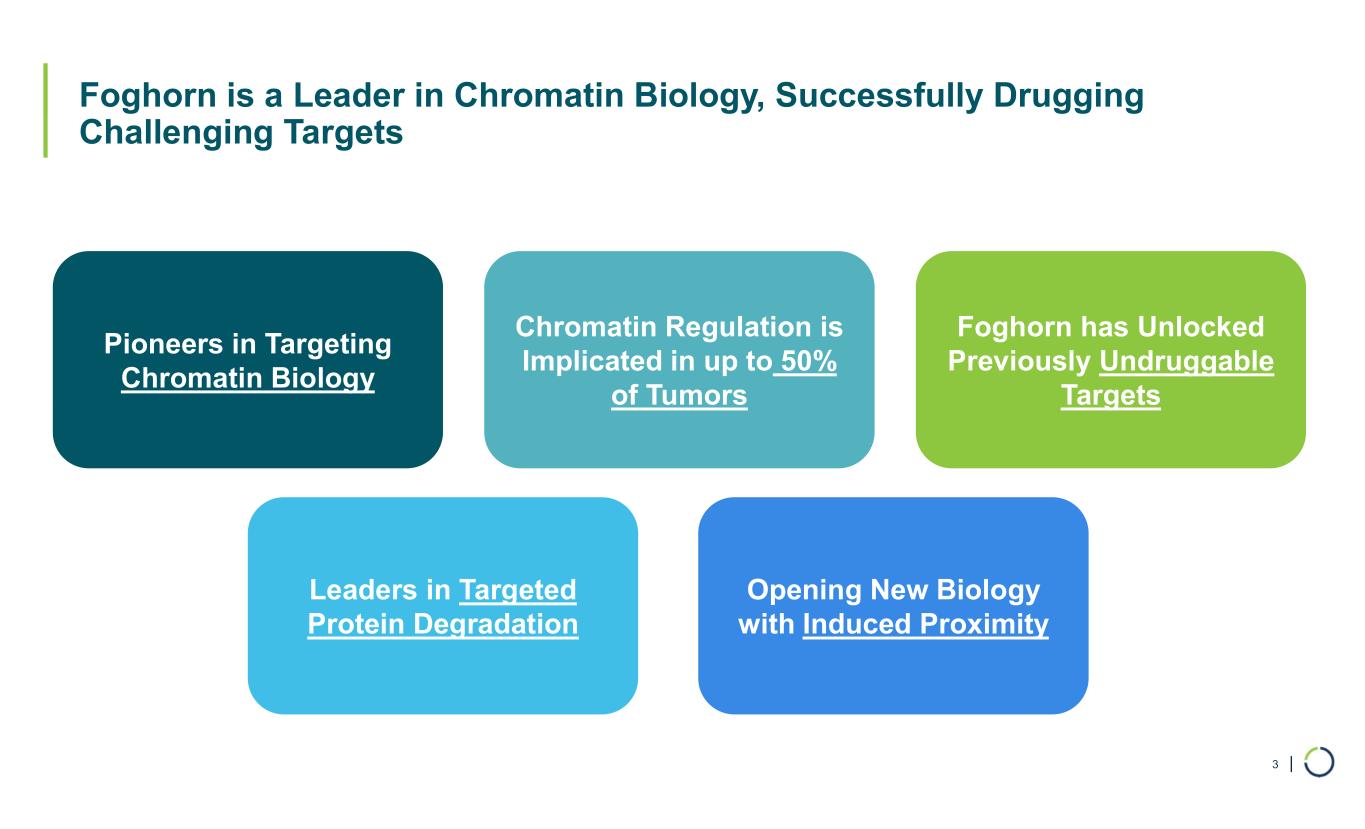
| Foghorn is a Leader in Chromatin Biology, Successfully Drugging Challenging Targets 3 Chromatin Regulation is Implicated in up to 50% of Tumors Foghorn has Unlocked Previously Undruggable Targets Leaders in Targeted Protein Degradation Pioneers in Targeting Chromatin Biology Opening New Biology with Induced Proximity
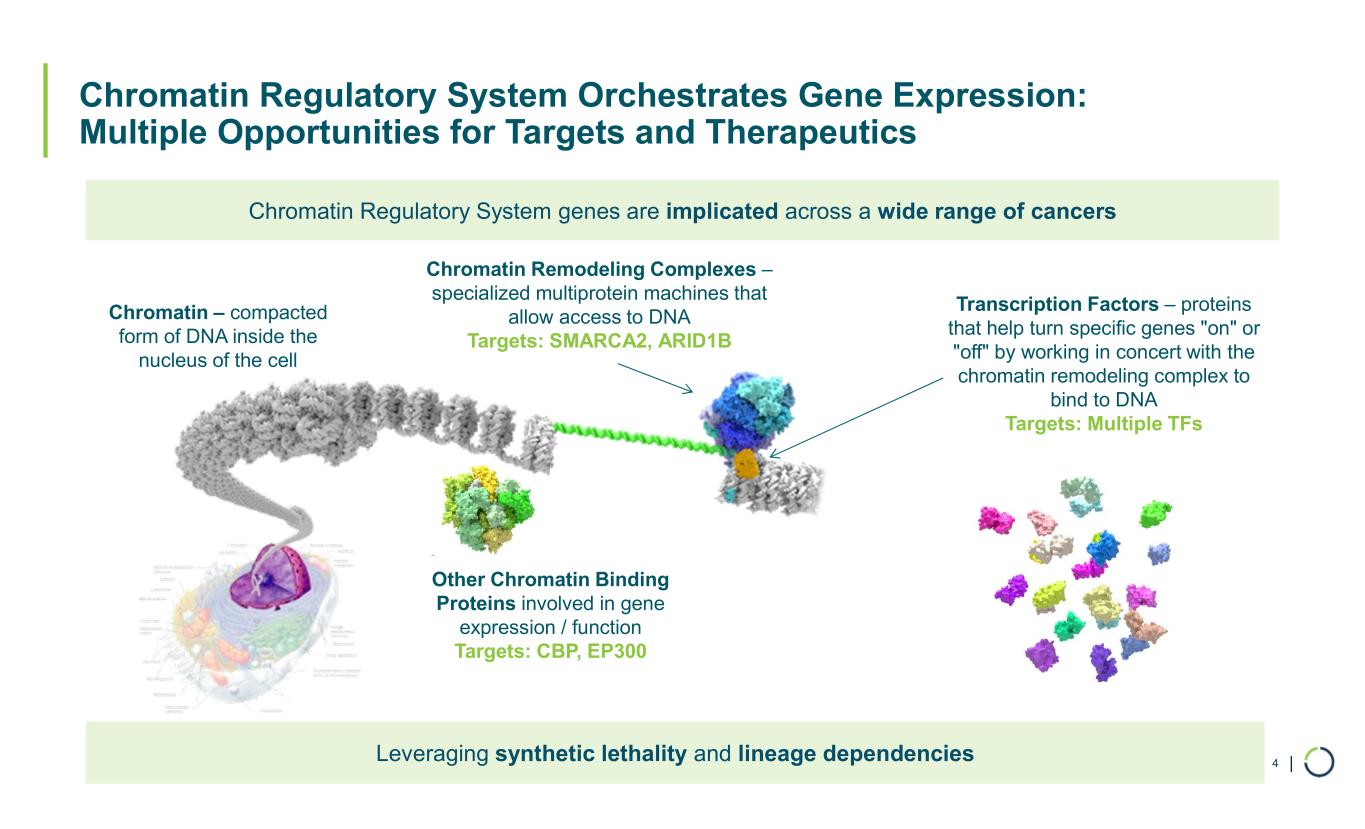
| Chromatin Regulatory System Orchestrates Gene Expression: Multiple Opportunities for Targets and Therapeutics 4 Chromatin – compacted form of DNA inside the nucleus of the cell Chromatin Remodeling Complexes – specialized multiprotein machines that allow access to DNA Targets: SMARCA2, ARID1B Transcription Factors – proteins that help turn specific genes "on" or "off" by working in concert with the chromatin remodeling complex to bind to DNA Targets: Multiple TFs Other Chromatin Binding Proteins involved in gene expression / function Targets: CBP, EP300 Chromatin Regulatory System genes are implicated across a wide range of cancers Leveraging synthetic lethality and lineage dependencies
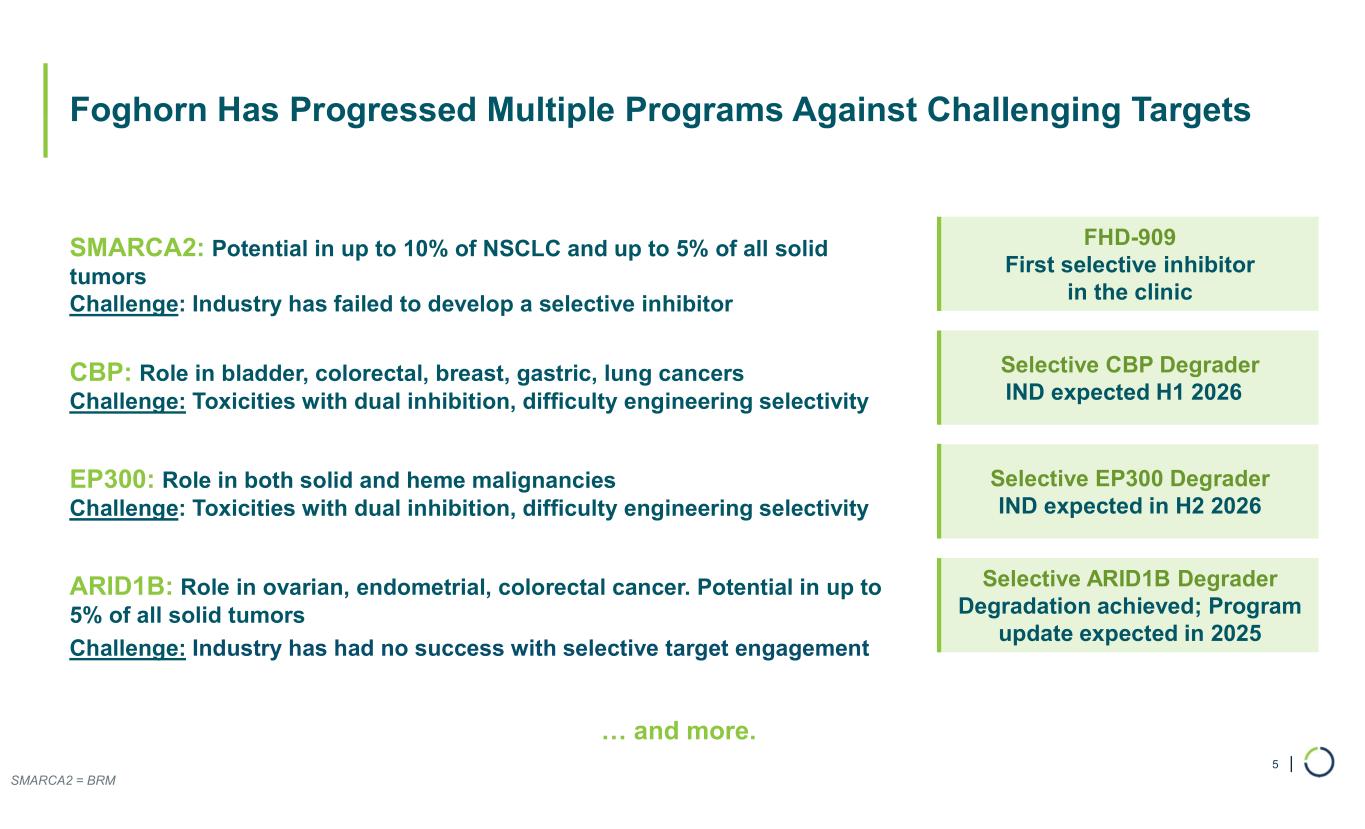
| Foghorn Has Progressed Multiple Programs Against Challenging Targets 5 SMARCA2: Potential in up to 10% of NSCLC and up to 5% of all solid tumors Challenge: Industry has failed to develop a selective inhibitor EP300: Role in both solid and heme malignancies Challenge: Toxicities with dual inhibition, difficulty engineering selectivity ARID1B: Role in ovarian, endometrial, colorectal cancer. Potential in up to 5% of all solid tumors Challenge: Industry has had no success with selective target engagement Selective EP300 Degrader IND expected in H2 2026 FHD-909 First selective inhibitor in the clinic CBP: Role in bladder, colorectal, breast, gastric, lung cancers Challenge: Toxicities with dual inhibition, difficulty engineering selectivity Selective CBP Degrader IND expected H1 2026 Selective ARID1B Degrader Degradation achieved; Program update expected in 2025 … and more. SMARCA2 = BRM
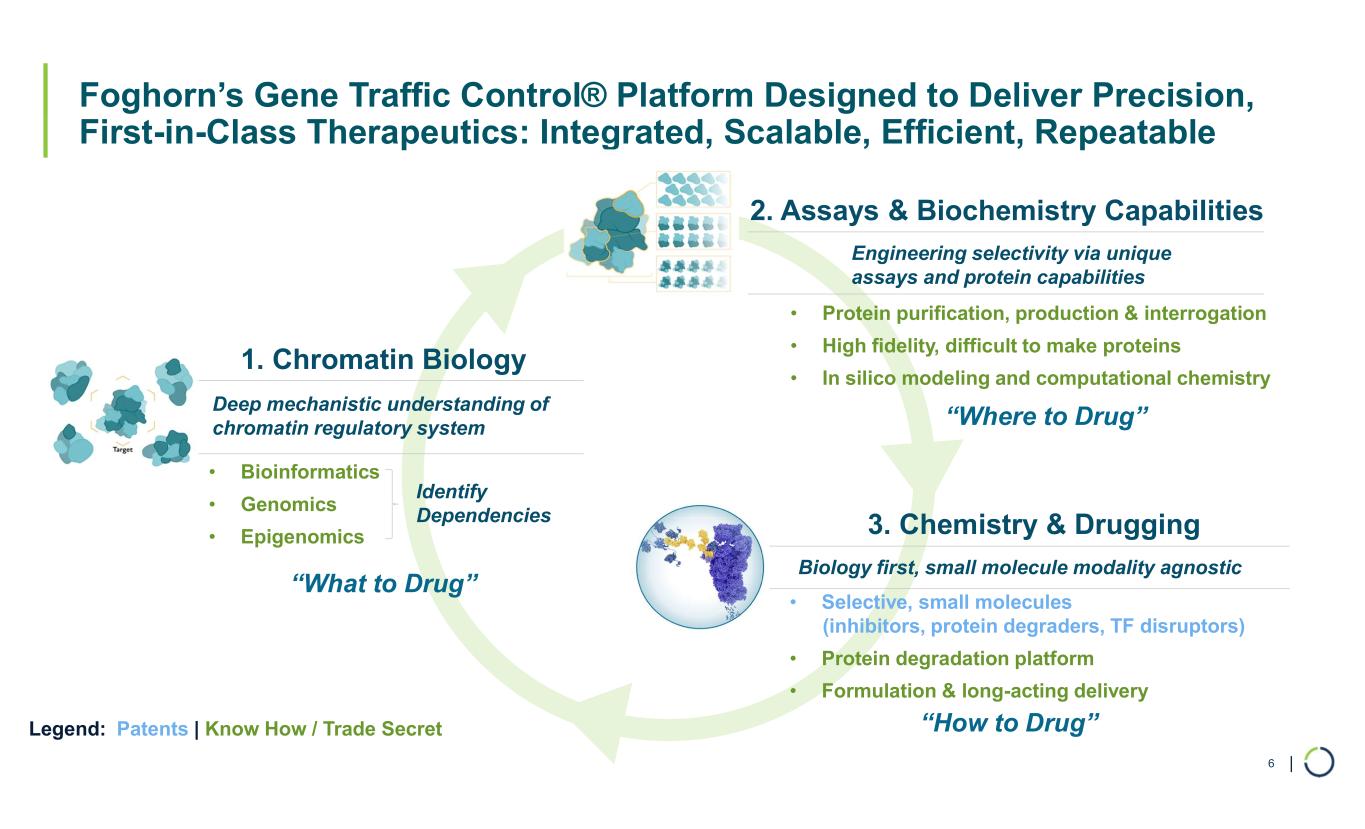
| Foghorn’s Gene Traffic Control® Platform Designed to Deliver Precision, First-in-Class Therapeutics: Integrated, Scalable, Efficient, Repeatable 6 1. Chromatin Biology • Bioinformatics • Genomics • Epigenomics 2. Assays & Biochemistry Capabilities 3. Chemistry & Drugging • Selective, small molecules (inhibitors, protein degraders, TF disruptors) • Protein degradation platform • Formulation & long-acting delivery Identify Dependencies Legend: Patents | Know How / Trade Secret “What to Drug” “How to Drug” Deep mechanistic understanding of chromatin regulatory system Biology first, small molecule modality agnostic Engineering selectivity via unique assays and protein capabilities • Protein purification, production & interrogation • High fidelity, difficult to make proteins • In silico modeling and computational chemistry “Where to Drug”
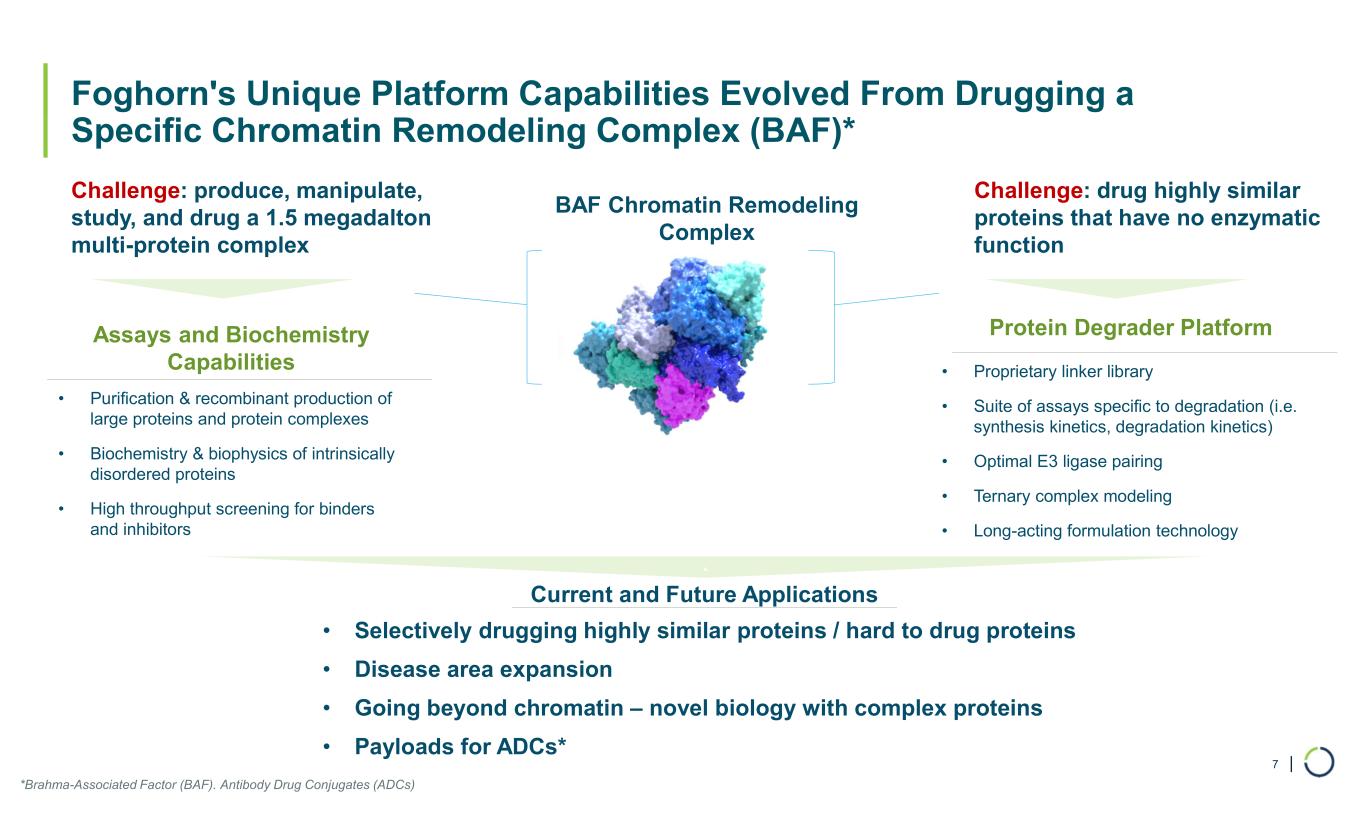
| Foghorn's Unique Platform Capabilities Evolved From Drugging a Specific Chromatin Remodeling Complex (BAF)* 7 • Purification & recombinant production of large proteins and protein complexes • Biochemistry & biophysics of intrinsically disordered proteins • High throughput screening for binders and inhibitors • Proprietary linker library • Suite of assays specific to degradation (i.e. synthesis kinetics, degradation kinetics) • Optimal E3 ligase pairing • Ternary complex modeling • Long-acting formulation technology Protein Degrader PlatformAssays and Biochemistry Capabilities BAF Chromatin Remodeling Complex Challenge: produce, manipulate, study, and drug a 1.5 megadalton multi-protein complex Challenge: drug highly similar proteins that have no enzymatic function • Selectively drugging highly similar proteins / hard to drug proteins • Disease area expansion • Going beyond chromatin – novel biology with complex proteins • Payloads for ADCs* Current and Future Applications ` *Brahma-Associated Factor (BAF). Antibody Drug Conjugates (ADCs)
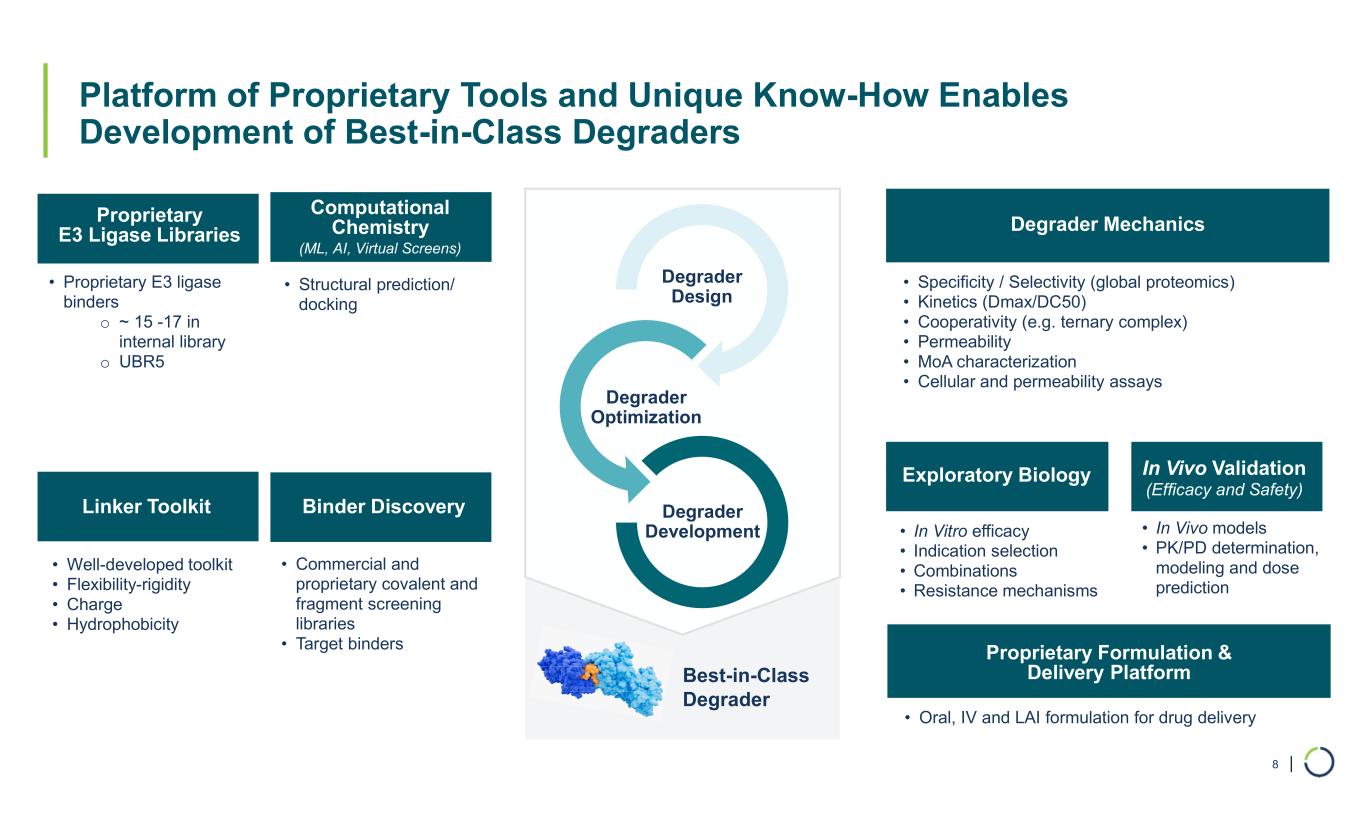
| Degrader Design Degrader Optimization Degrader Development Best-in-Class Degrader • In Vitro efficacy • Indication selection • Combinations • Resistance mechanisms • In Vivo models • PK/PD determination, modeling and dose prediction • Proprietary E3 ligase binders o ~ 15 -17 in internal library o UBR5 • Structural prediction/ docking • Well-developed toolkit • Flexibility-rigidity • Charge • Hydrophobicity • Commercial and proprietary covalent and fragment screening libraries • Target binders • Specificity / Selectivity (global proteomics) • Kinetics (Dmax/DC50) • Cooperativity (e.g. ternary complex) • Permeability • MoA characterization • Cellular and permeability assays • Oral, IV and LAI formulation for drug delivery Computational Chemistry (ML, AI, Virtual Screens) Proprietary E3 Ligase Libraries Binder DiscoveryLinker Toolkit Degrader Mechanics Exploratory Biology In Vivo Validation (Efficacy and Safety) Proprietary Formulation & Delivery Platform Platform of Proprietary Tools and Unique Know-How Enables Development of Best-in-Class Degraders 8
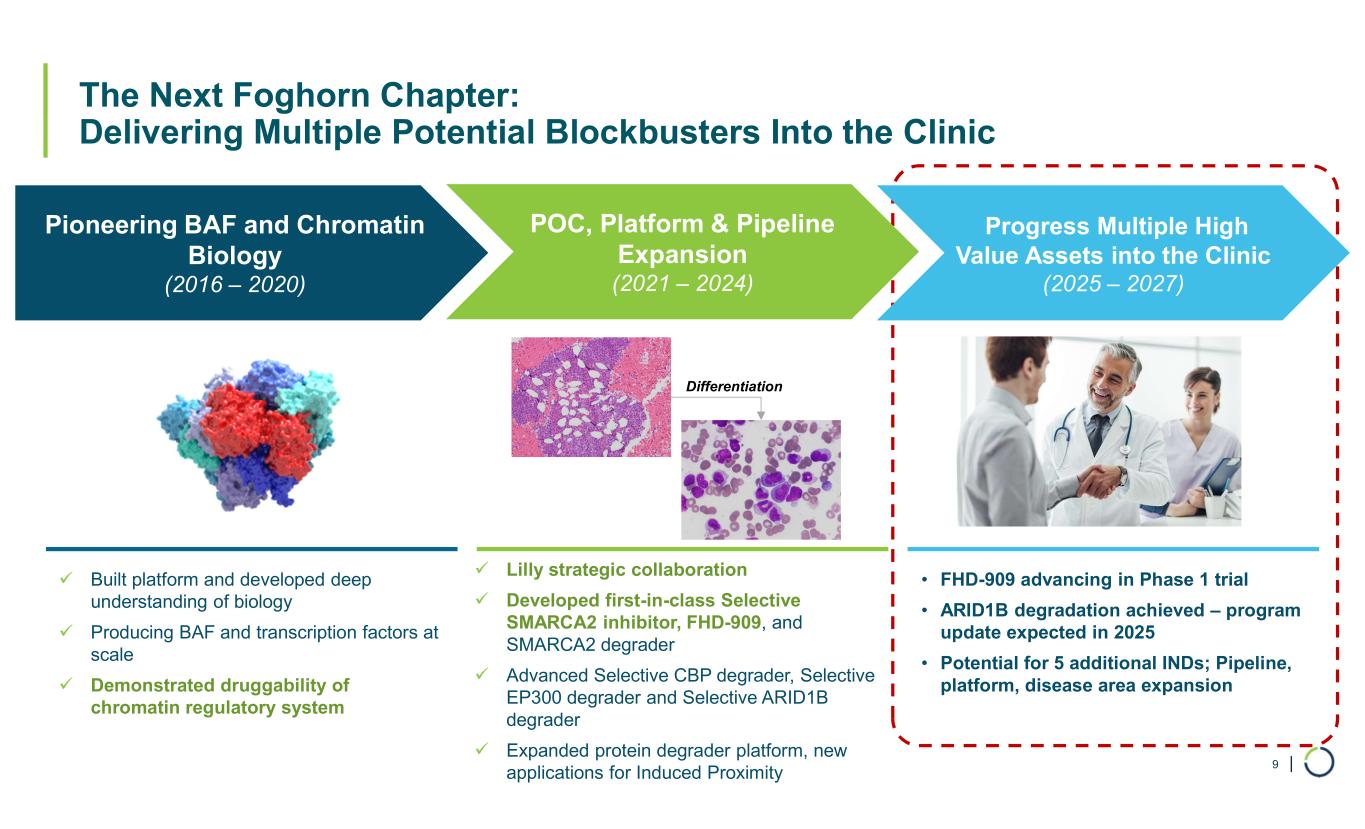
| The Next Foghorn Chapter: Delivering Multiple Potential Blockbusters Into the Clinic 9 Pioneering BAF and Chromatin Biology (2016 – 2020) Built platform and developed deep understanding of biology Producing BAF and transcription factors at scale Demonstrated druggability of chromatin regulatory system Lilly strategic collaboration Developed first-in-class Selective SMARCA2 inhibitor, FHD-909, and SMARCA2 degrader Advanced Selective CBP degrader, Selective EP300 degrader and Selective ARID1B degrader Expanded protein degrader platform, new applications for Induced Proximity • FHD-909 advancing in Phase 1 trial • ARID1B degradation achieved – program update expected in 2025 • Potential for 5 additional INDs; Pipeline, platform, disease area expansion Differentiation POC, Platform & Pipeline Expansion (2021 – 2024) Progress Multiple High Value Assets into the Clinic (2025 – 2027)
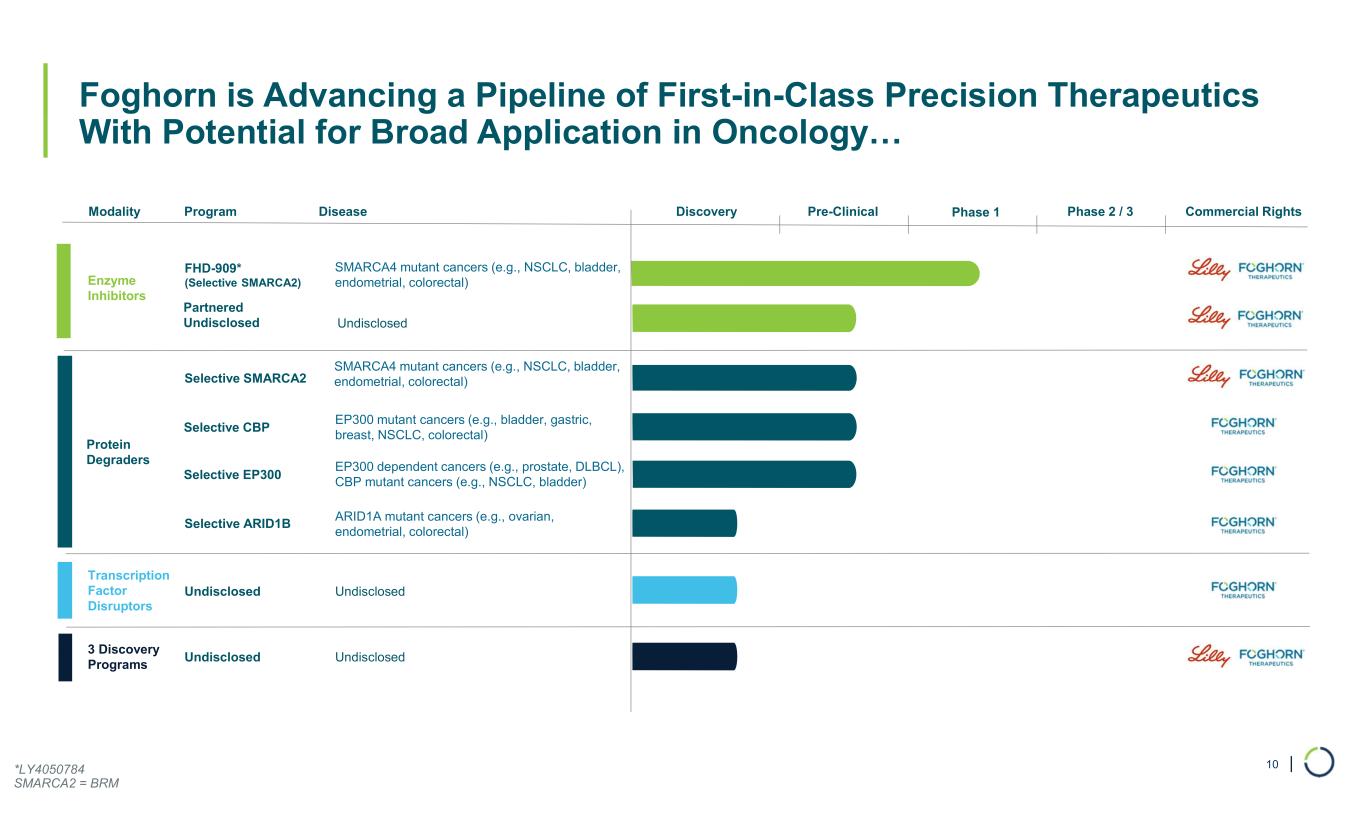
| Foghorn is Advancing a Pipeline of First-in-Class Precision Therapeutics With Potential for Broad Application in Oncology… 10 Modality Program Phase 1 Enzyme Inhibitors Transcription Factor Disruptors Undisclosed Protein Degraders Commercial Rights FHD-909* (Selective SMARCA2) 3 Discovery Programs Undisclosed Partnered Undisclosed Disease SMARCA4 mutant cancers (e.g., NSCLC, bladder, endometrial, colorectal) Selective SMARCA2 SMARCA4 mutant cancers (e.g., NSCLC, bladder, endometrial, colorectal) Selective ARID1B ARID1A mutant cancers (e.g., ovarian, endometrial, colorectal) Selective CBP EP300 mutant cancers (e.g., bladder, gastric, breast, NSCLC, colorectal) Selective EP300 EP300 dependent cancers (e.g., prostate, DLBCL), CBP mutant cancers (e.g., NSCLC, bladder) Undisclosed Undisclosed Undisclosed Pre-Clinical Phase 2 / 3Discovery *LY4050784 SMARCA2 = BRM

| …With Multiple Near-Term Value Inflection Points Through 2026 11 April 2025 (AACR)Preclinical Combination Data FHD-909 (LY4050784) (Selective SMARCA2 Inhibitor) ConfidentialIND / Phase 1 InitiationSelective SMARCA2 Degrader 2026IND / Phase 1 InitiationSelective CBP Degrader 2026IND / Phase 1 InitiationSelective EP300 Degrader ConfidentialTarget Disclosure and INDLilly Target #2 Program Update 2025 Selective Degradation AchievedSelective ARID1B Degrader SMARCA2 = BRM SMARCA4 = BRG1 ConfidentialPhase 1 Dose Escalation Data
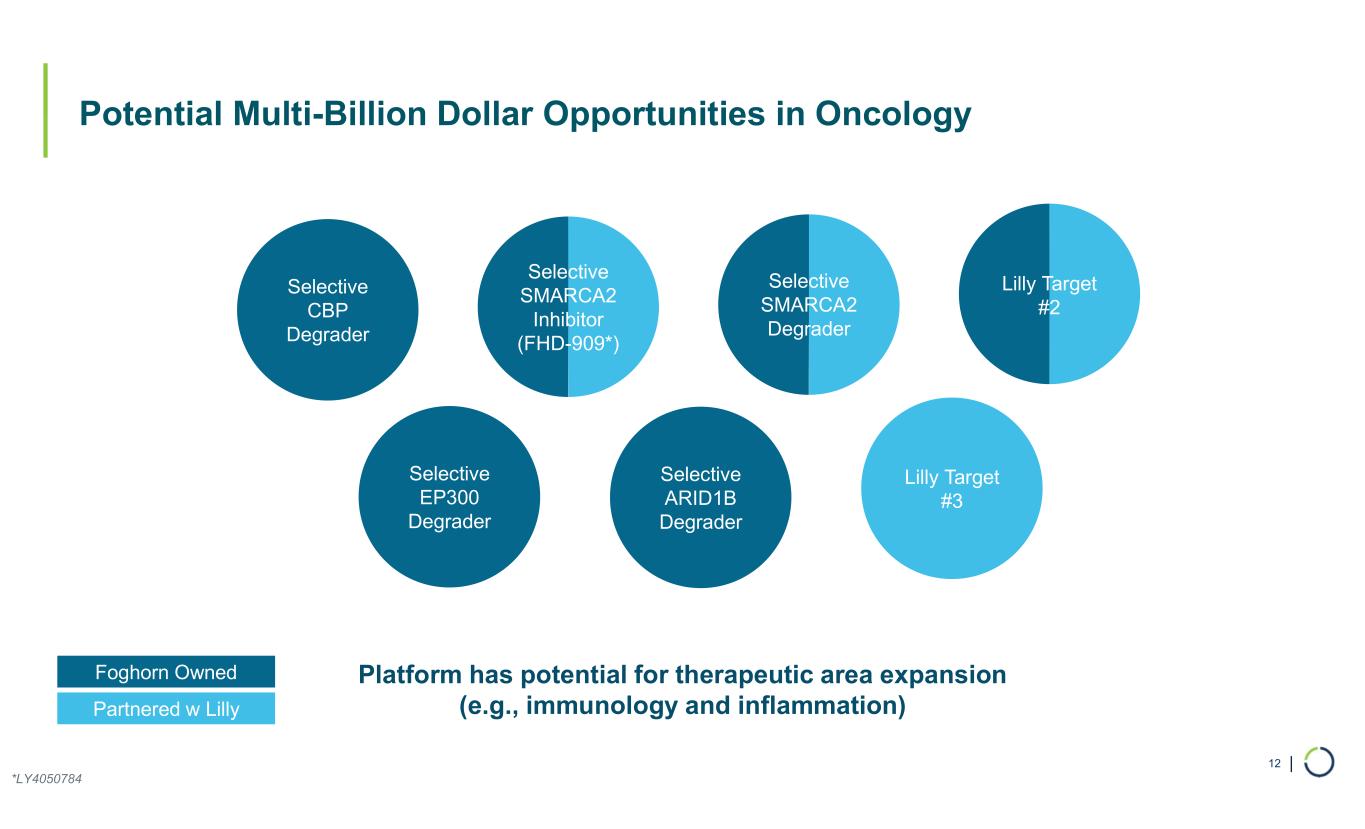
| Potential Multi-Billion Dollar Opportunities in Oncology 12 Foghorn Owned Selective EP300 Degrader Lilly Target #3 Selective ARID1B Degrader Platform has potential for therapeutic area expansion (e.g., immunology and inflammation)Partnered w Lilly Selective SMARCA2 Inhibitor (FHD-909*) Selective SMARCA2 Degrader Lilly Target #2 Selective CBP Degrader *LY4050784

Clinical & Preclinical Programs • FHD-909 (LY4050784) – Selective SMARCA2 Inhibitor • Selective CBP Degrader • Selective EP300 Degrader • Selective ARID1B Degrader 13
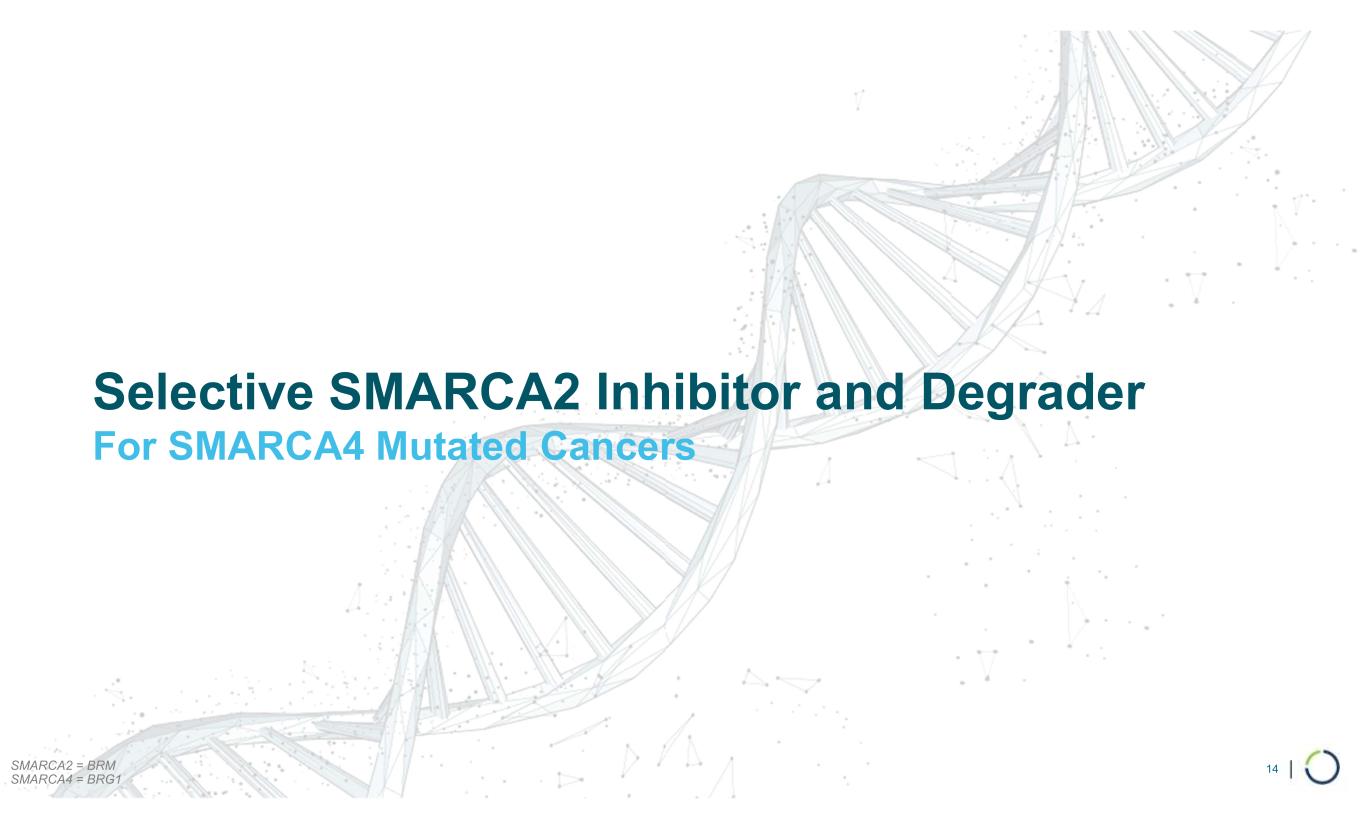
Selective SMARCA2 Inhibitor and Degrader For SMARCA4 Mutated Cancers SMARCA2 = BRM SMARCA4 = BRG1 14
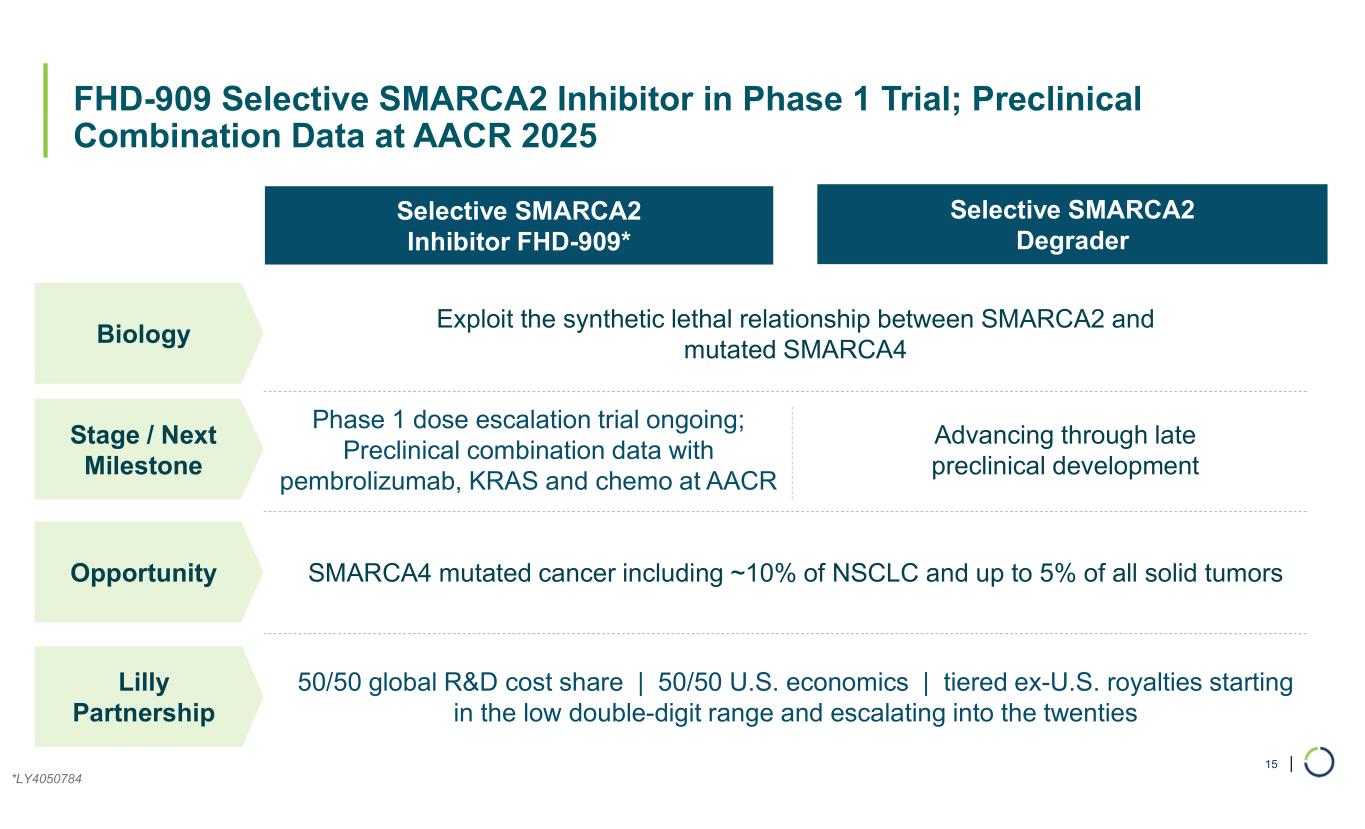
| FHD-909 Selective SMARCA2 Inhibitor in Phase 1 Trial; Preclinical Combination Data at AACR 2025 15 Selective SMARCA2 Inhibitor FHD-909* Selective SMARCA2 Degrader Biology Exploit the synthetic lethal relationship between SMARCA2 and mutated SMARCA4 Stage / Next Milestone Phase 1 dose escalation trial ongoing; Preclinical combination data with pembrolizumab, KRAS and chemo at AACR Advancing through late preclinical development Opportunity SMARCA4 mutated cancer including ~10% of NSCLC and up to 5% of all solid tumors Lilly Partnership 50/50 global R&D cost share | 50/50 U.S. economics | tiered ex-U.S. royalties starting in the low double-digit range and escalating into the twenties *LY4050784
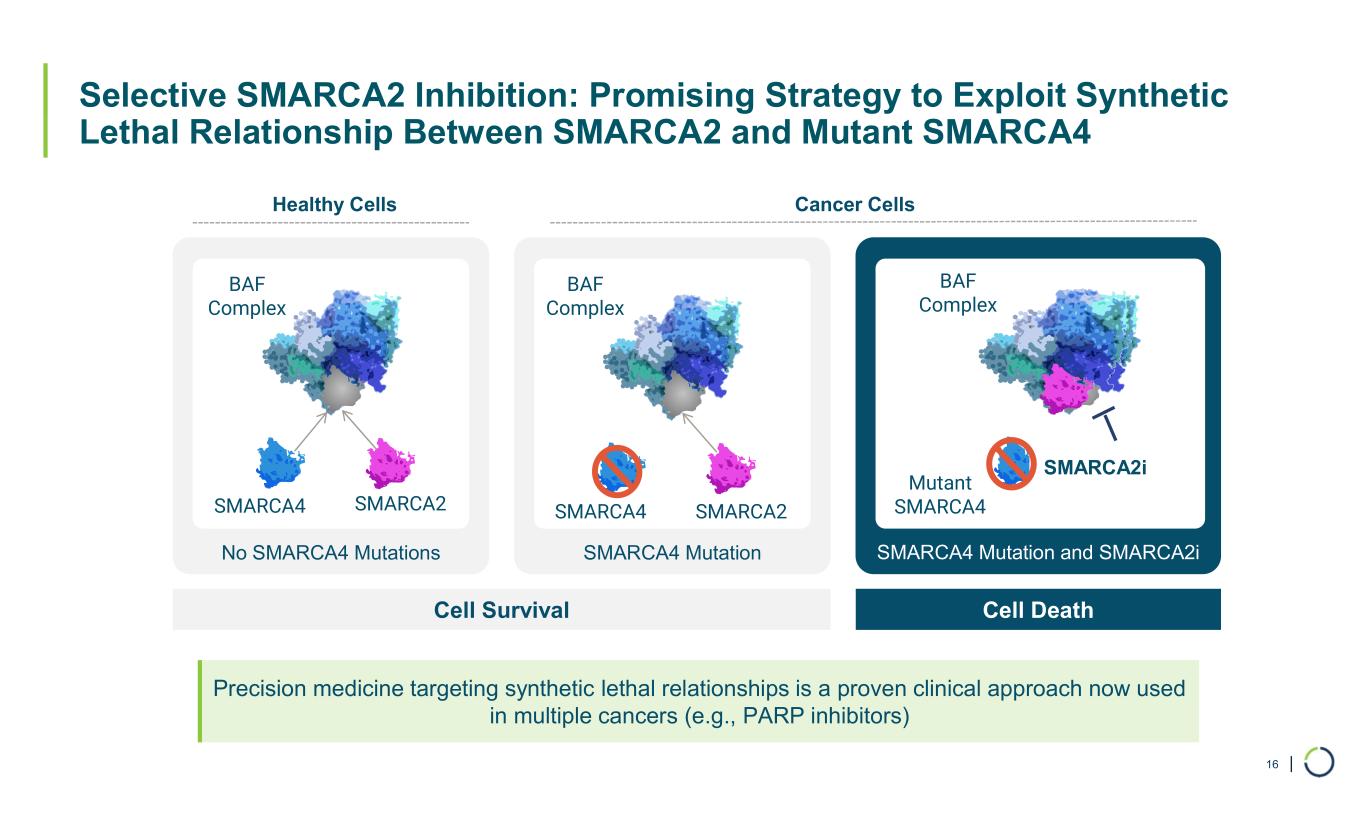
| Selective SMARCA2 Inhibition: Promising Strategy to Exploit Synthetic Lethal Relationship Between SMARCA2 and Mutant SMARCA4 16 No SMARCA4 Mutations SMARCA4 Mutation SMARCA4 Mutation and SMARCA2i Cell Survival Cell Death Healthy Cells Cancer Cells SMARCA4 SMARCA2 BAF Complex BAF Complex Mutant SMARCA4 BAF Complex SMARCA2i Precision medicine targeting synthetic lethal relationships is a proven clinical approach now used in multiple cancers (e.g., PARP inhibitors) SMARCA4 SMARCA2
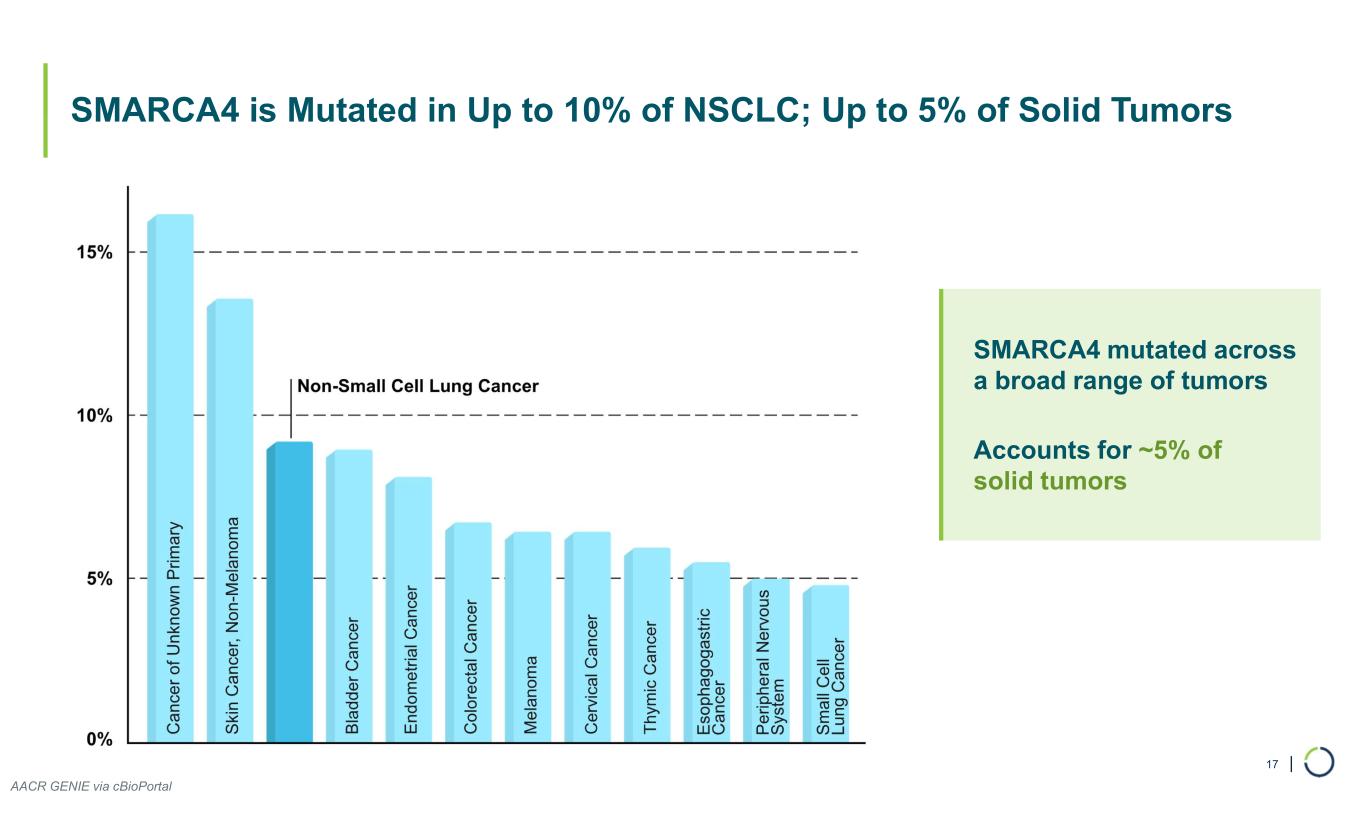
| SMARCA4 is Mutated in Up to 10% of NSCLC; Up to 5% of Solid Tumors 17 SMARCA4 mutated across a broad range of tumors Accounts for ~5% of solid tumors AACR GENIE via cBioPortal
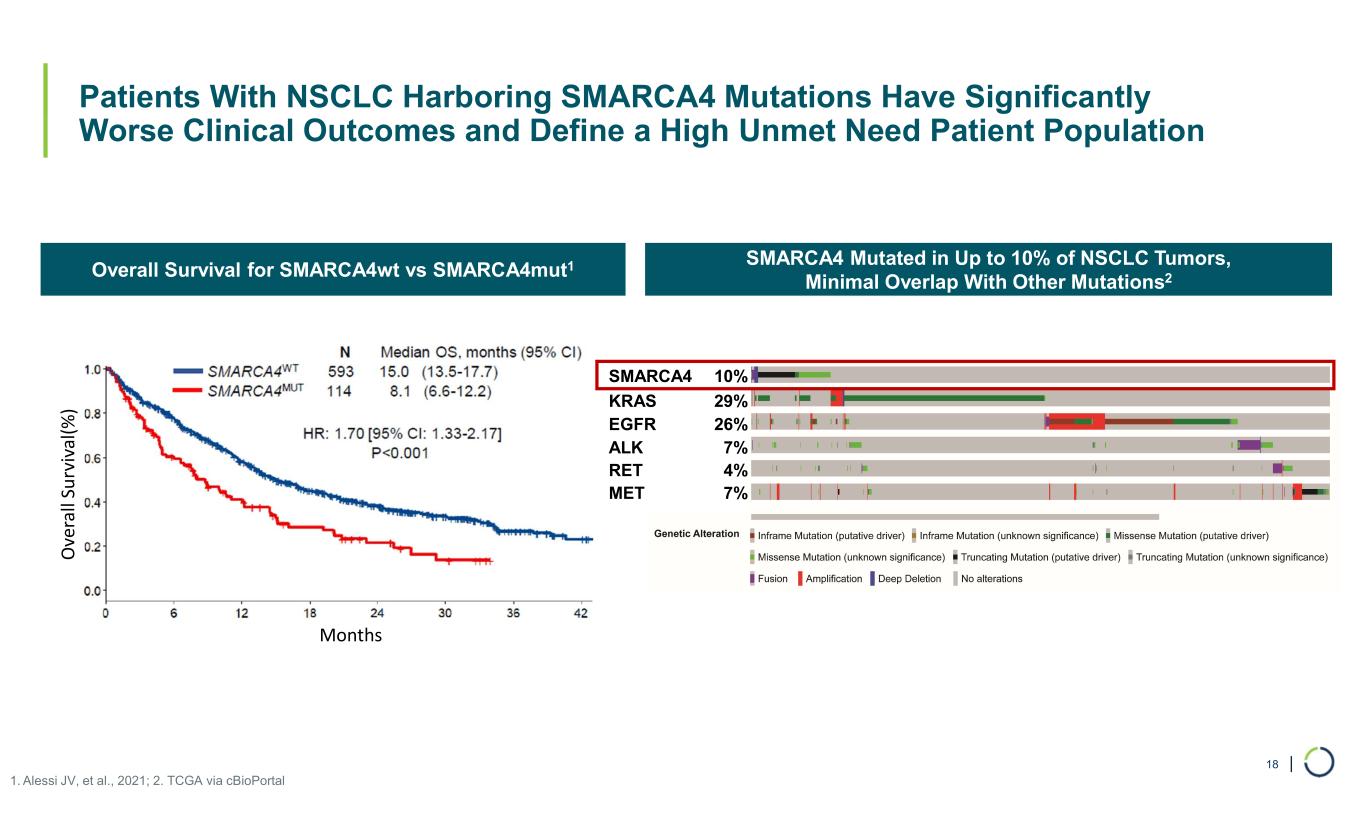
| SMARCA4 Mutated in Up to 10% of NSCLC Tumors, Minimal Overlap With Other Mutations2Overall Survival for SMARCA4wt vs SMARCA4mut1 Patients With NSCLC Harboring SMARCA4 Mutations Have Significantly Worse Clinical Outcomes and Define a High Unmet Need Patient Population 18 SMARCA4 10% KRAS 29% EGFR 26% ALK 7% RET 4% MET 7% 1. Alessi JV, et al., 2021; 2. TCGA via cBioPortal O ve ra ll Su rv iv al (% ) Months
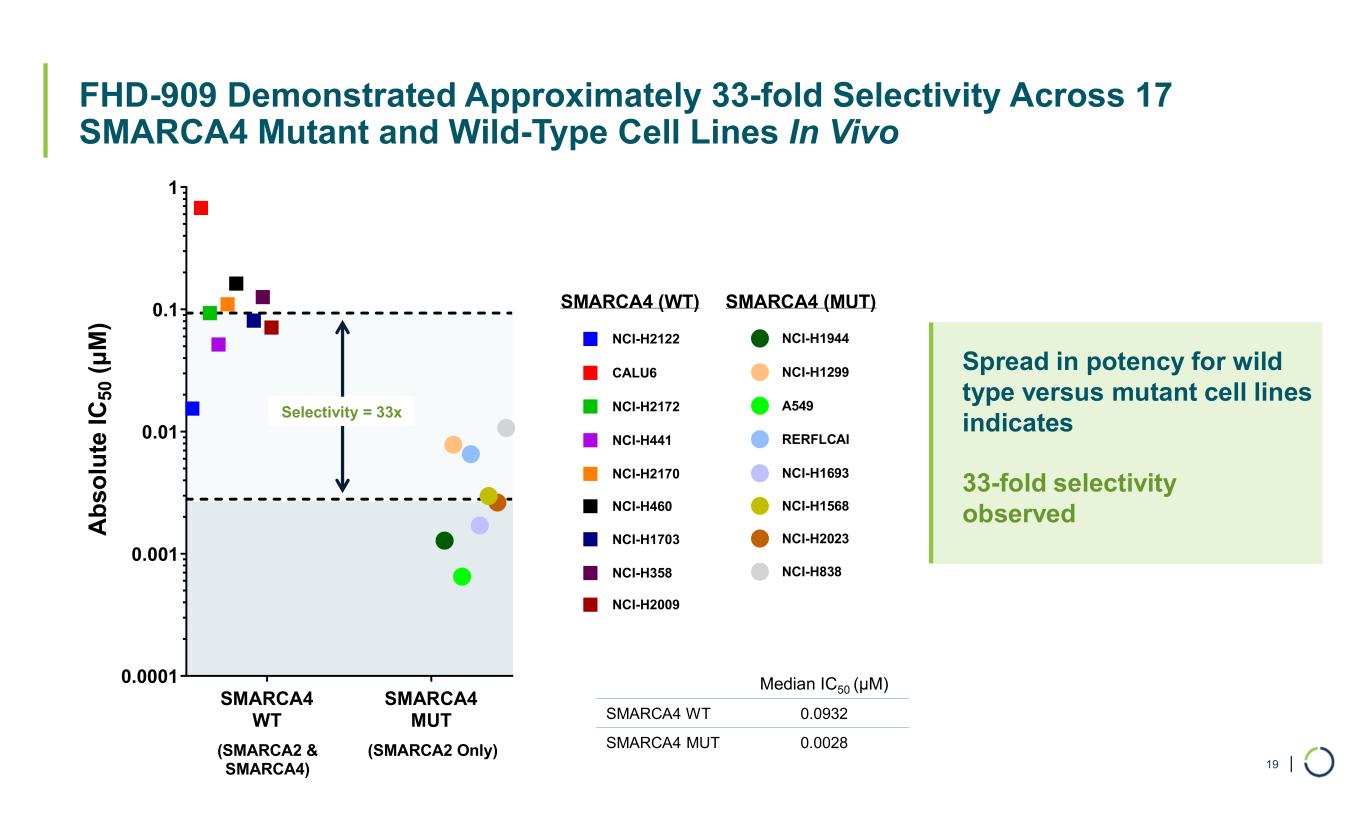
| SMARCA4 WT SMARCA4 MUT 0.0001 0.001 0.01 0.1 1 A b so lu te I C 50 ( μ M ) NCI-H2122 CALU6 NCI-H2172 NCI-H441 NCI-H2170 NCI-H460 NCI-H1703 NCI-H358 NCI-H2009 NCI-H1944 NCI-H1299 A549 RERFLCAI NCI-H1693 NCI-H1568 NCI-H2023 NCI-H838 SMARCA4 (WT) SMARCA4 (MUT) (SMARCA2 Only)(SMARCA2 & SMARCA4) FHD-909 Demonstrated Approximately 33-fold Selectivity Across 17 SMARCA4 Mutant and Wild-Type Cell Lines In Vivo 19 Spread in potency for wild type versus mutant cell lines indicates 33-fold selectivity observed Selectivity = 33x Median IC50 (µM) 0.0932SMARCA4 WT 0.0028SMARCA4 MUT
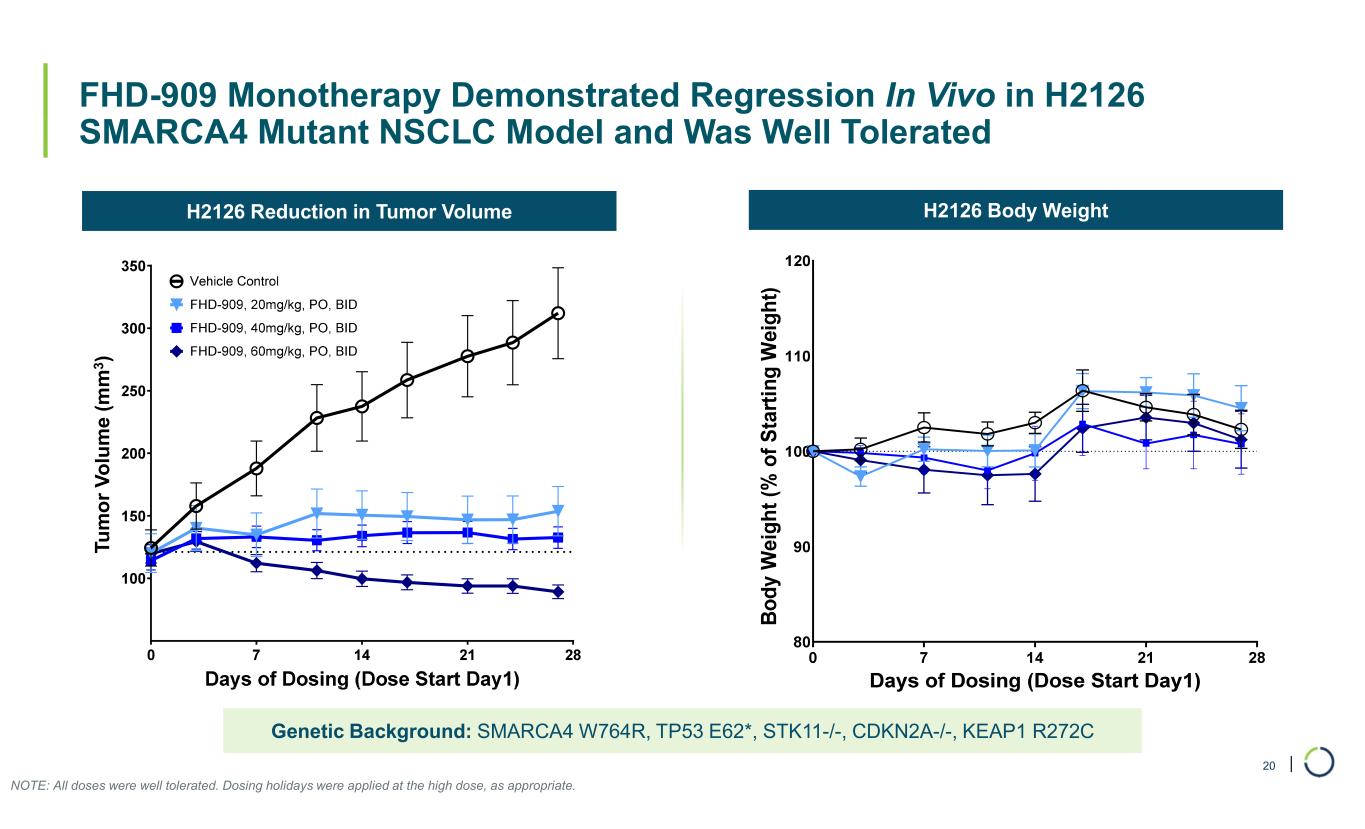
| FHD-909 Monotherapy Demonstrated Regression In Vivo in H2126 SMARCA4 Mutant NSCLC Model and Was Well Tolerated 20 H2126 Reduction in Tumor Volume H2126 Body Weight Genetic Background: SMARCA4 W764R, TP53 E62*, STK11-/-, CDKN2A-/-, KEAP1 R272C NOTE: All doses were well tolerated. Dosing holidays were applied at the high dose, as appropriate. T u m o r vo lu m e (m m 3 ) Tu m o r V o lu m e (m m 3 )
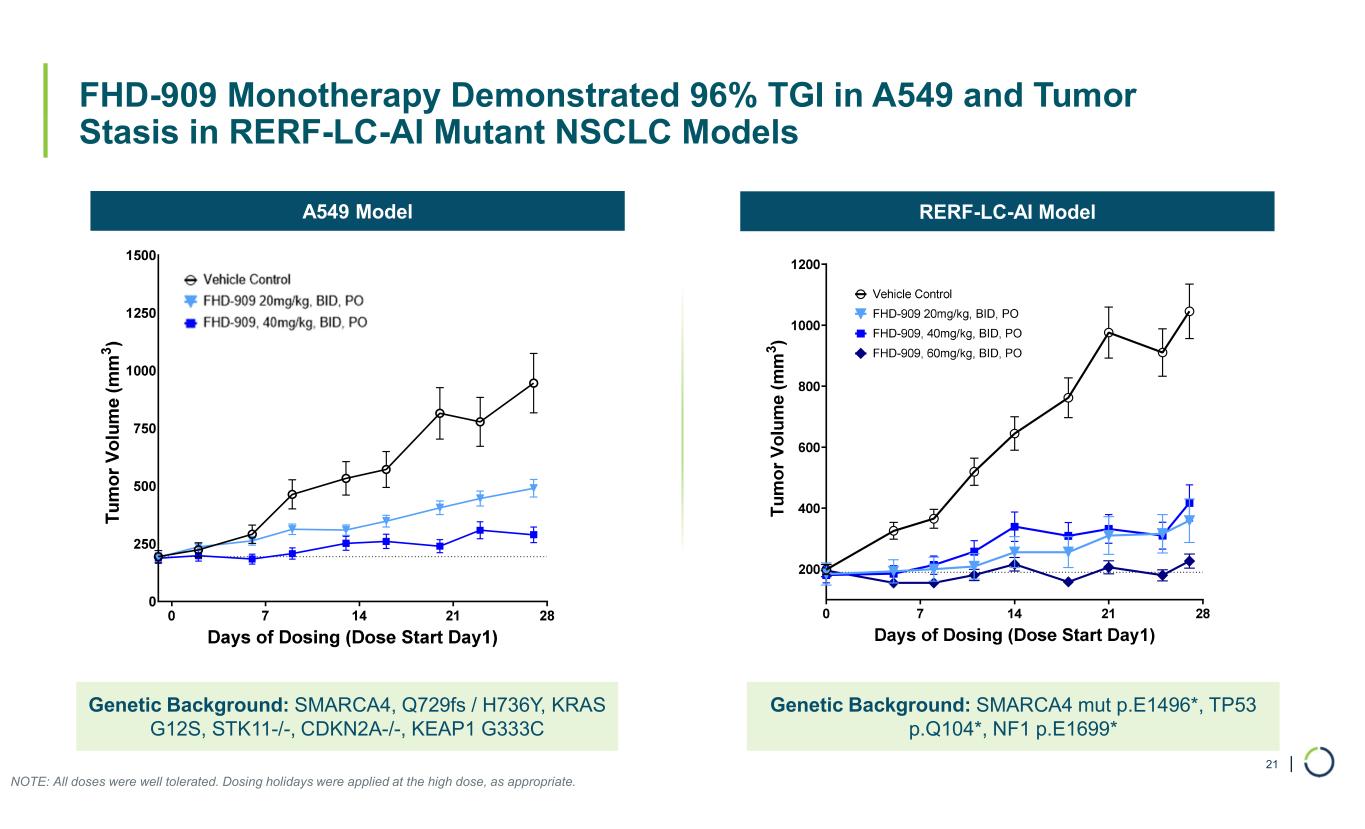
| RERF-LC-AI Model FHD-909 Monotherapy Demonstrated 96% TGI in A549 and Tumor Stasis in RERF-LC-AI Mutant NSCLC Models 21 A549 Model NOTE: All doses were well tolerated. Dosing holidays were applied at the high dose, as appropriate. Genetic Background: SMARCA4, Q729fs / H736Y, KRAS G12S, STK11-/-, CDKN2A-/-, KEAP1 G333C Genetic Background: SMARCA4 mut p.E1496*, TP53 p.Q104*, NF1 p.E1699*

| FHD-909 Monotherapy Demonstrated Regression in H1793 SMARCA4 Mutant NSCLC Model 22 H1793 Model NOTE: All doses were well tolerated. Dosing holidays were applied at the high dose, as appropriate. Genetic Background: SMARCA4, E514*, TP53 R209* R273H, ARID1A C884* 0 7 14 21 28 100 200 300 400 500 Days of Dosing (Dose Start Day1) Vehicle Control FHD-909, 20mg/kg, BID, PO FHD-909, 40mg/kg, BID, PO FHD-909, 60mg/kg, BID, PO • FHD-909 delivered across range of SMARCA4 mut xenograft models • Results ranging from impressive TGI to regression as monotherapy • All doses across all four models were well tolerated

| FHD-909 (LY4050784) Trial Design • Restricted to SMARCA4 mutated tumors • SMARCA4 mutant status confirmed by standard NGS panel • Further enrichment for NSCLC patients as trial progresses • Tumor histology agnostic • Enrolling in US and Japan 23 Dose Escalation Dose Expansion • Arm 1: SMARCA4 mutant NSCLC • Arm 2: Other SMARCA4 mutant tumors (e.g., bladder, endometrial, colorectal) • Potential for combination arm(s) FHD-909 preclinical combination data with pembrolizumab, KRAS inhibitors and chemo to be presented at the AACR Annual Meeting, April 2025

| Selective SMARCA2 Degrader Achieved Complete SMARCA2 Degradation and Cell Growth Inhibition In Vitro 24 Degraders Caused Time- and Dose-Dependent SMARCA2 Degradation Antiproliferative Effects in A549 Mutant NSCLC Model A549 Ten-Day Proliferation AssaySMARCA2 / SMARCA4 HIBIT Data SMARCA2 SMARCA4 % D eg ra d at io n Concentration (uM) 0 25 50 75 100 1E-3 0.01 0.1 1 10 NOTE: Data as of Q4 2021.
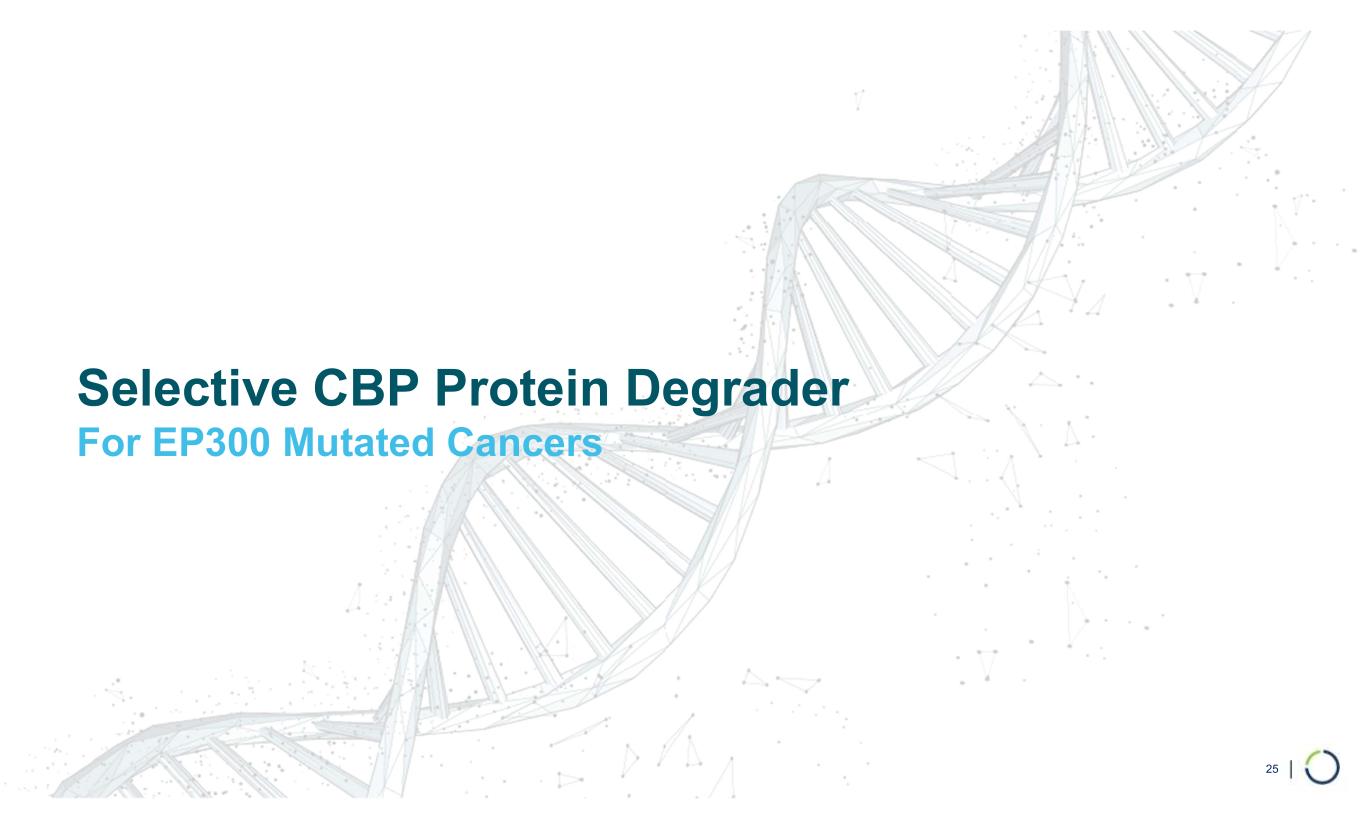
Selective CBP Protein Degrader For EP300 Mutated Cancers 25
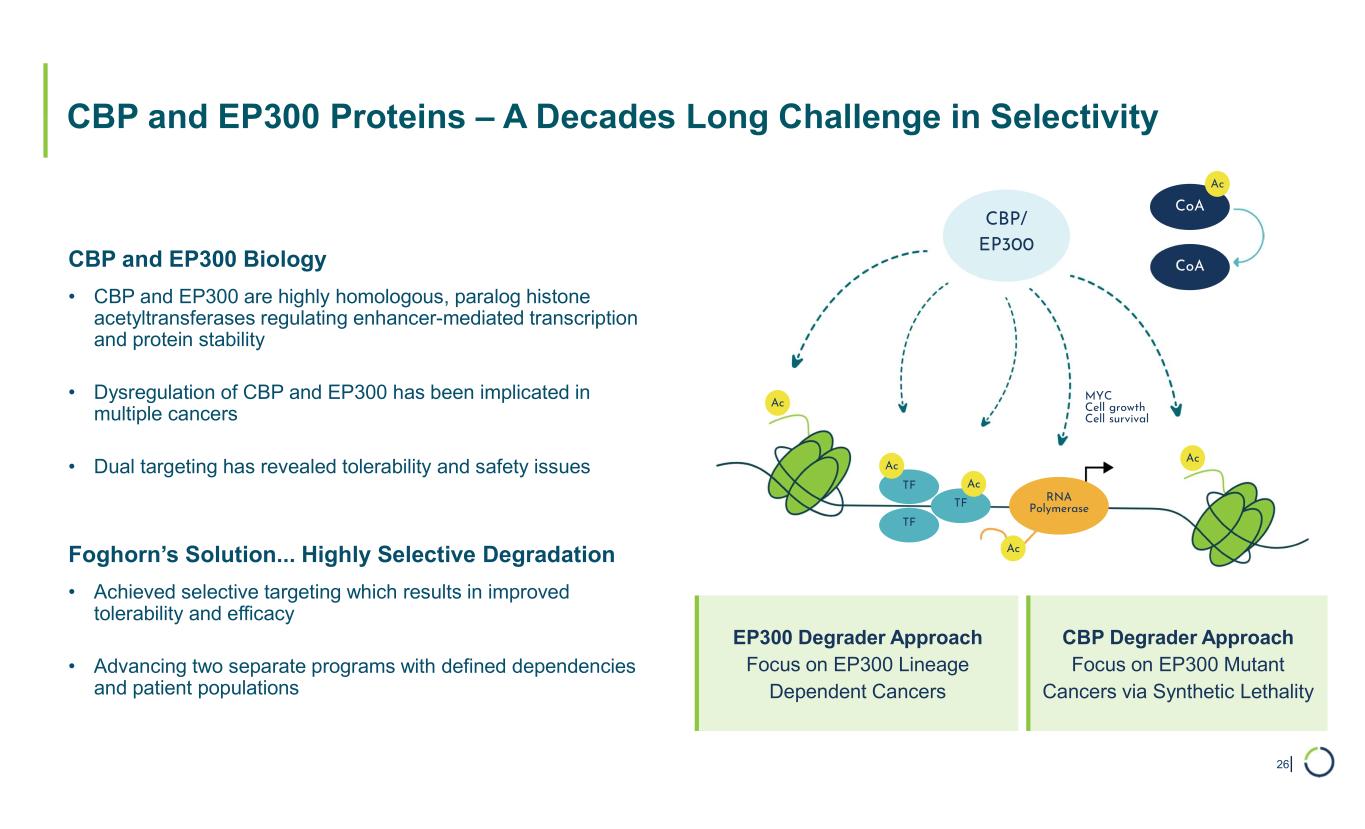
| CBP and EP300 Proteins – A Decades Long Challenge in Selectivity 26 CBP and EP300 Biology • CBP and EP300 are highly homologous, paralog histone acetyltransferases regulating enhancer-mediated transcription and protein stability • Dysregulation of CBP and EP300 has been implicated in multiple cancers • Dual targeting has revealed tolerability and safety issues Foghorn’s Solution... Highly Selective Degradation • Achieved selective targeting which results in improved tolerability and efficacy • Advancing two separate programs with defined dependencies and patient populations CoA TF TF TF RNA Polymerase Ac Ac CoA Ac Ac Ac CBP/ EP300 MYC Cell growth Cell survival Ac EP300 Degrader Approach Focus on EP300 Lineage Dependent Cancers CBP Degrader Approach Focus on EP300 Mutant Cancers via Synthetic Lethality
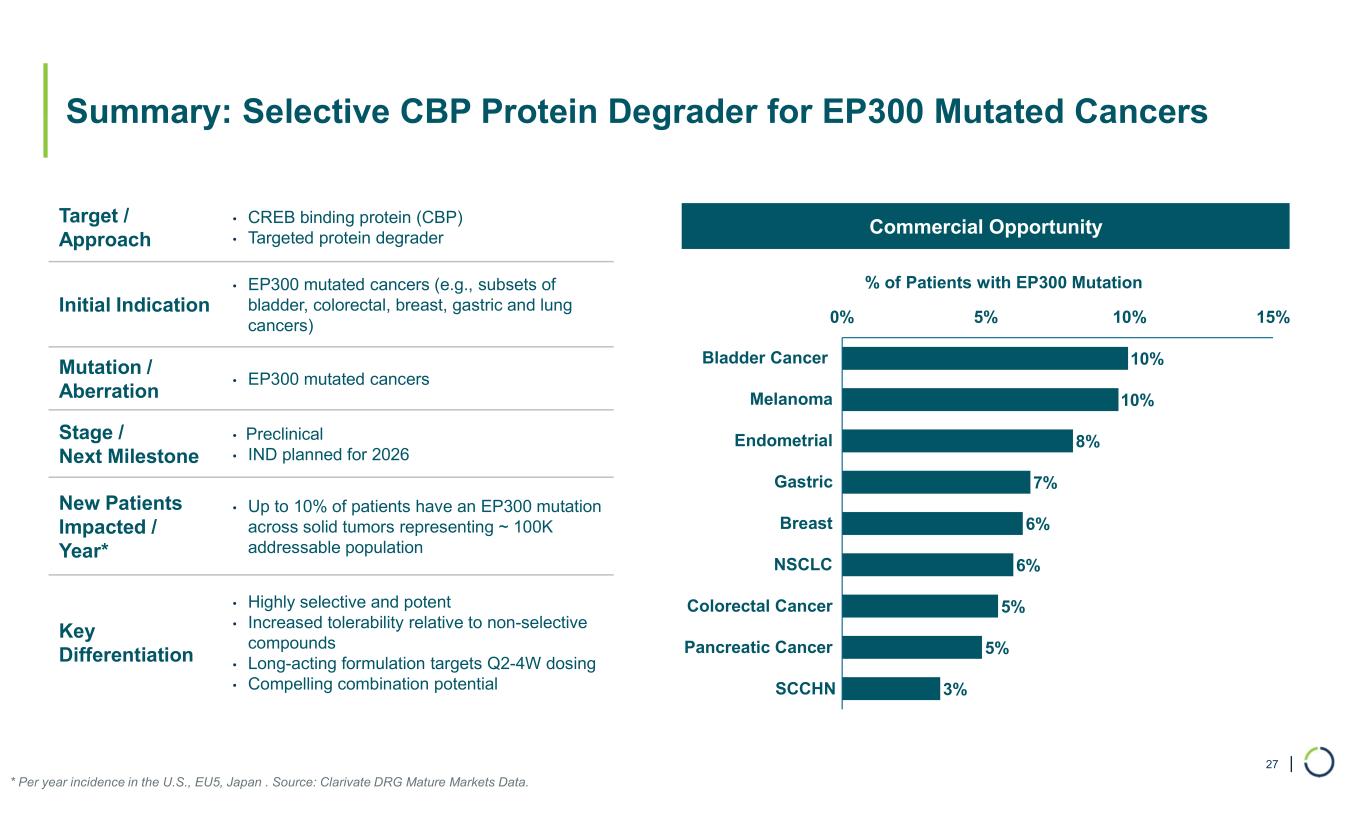
| Summary: Selective CBP Protein Degrader for EP300 Mutated Cancers 27 * Per year incidence in the U.S., EU5, Japan . Source: Clarivate DRG Mature Markets Data. • CREB binding protein (CBP) • Targeted protein degrader Target / Approach • EP300 mutated cancers (e.g., subsets of bladder, colorectal, breast, gastric and lung cancers) Initial Indication • EP300 mutated cancers Mutation / Aberration • Preclinical • IND planned for 2026 Stage / Next Milestone • Up to 10% of patients have an EP300 mutation across solid tumors representing ~ 100K addressable population New Patients Impacted / Year* • Highly selective and potent • Increased tolerability relative to non-selective compounds • Long-acting formulation targets Q2-4W dosing • Compelling combination potential Key Differentiation 10% 10% 8% 7% 6% 6% 5% 5% 3% 0% 5% 10% 15% Melanoma NSCLC Bladder Cancer Endometrial Gastric Breast Pancreatic Cancer Colorectal Cancer Commercial Opportunity SCCHN % of Patients with EP300 Mutation
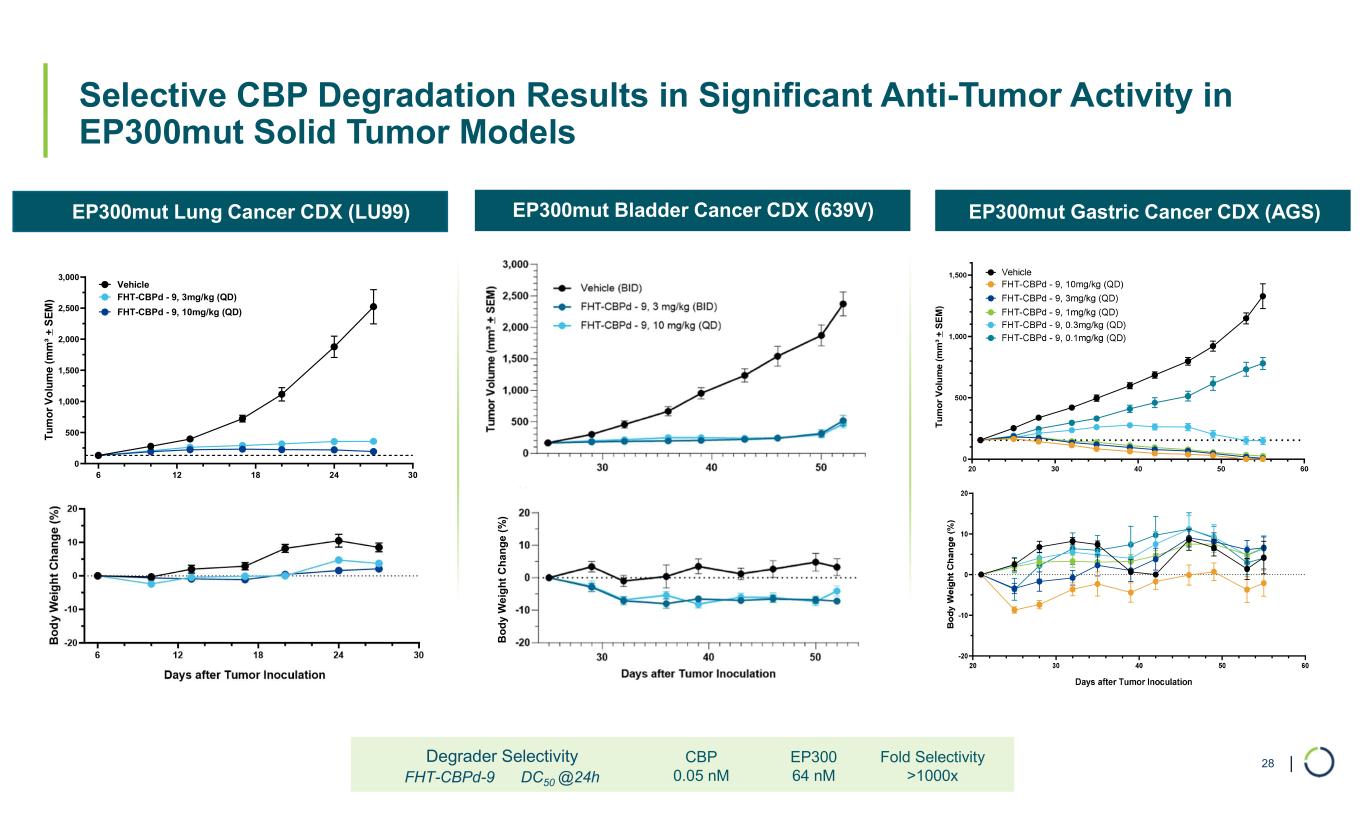
| EP300mut Lung Cancer CDX (LU99) EP300mut Bladder Cancer CDX (639V) EP300mut Gastric Cancer CDX (AGS) Selective CBP Degradation Results in Significant Anti-Tumor Activity in EP300mut Solid Tumor Models 28Fold Selectivity >1000x EP300 64 nM CBP 0.05 nM Degrader Selectivity FHT-CBPd-9 DC50 @24h 6 12 18 24 30 0 500 1,000 1,500 2,000 2,500 3,000 Vehicle FHT-CBPd - 9, 10mg/kg (QD) FHT-CBPd - 9, 3mg/kg (QD) B o d y W e ig h t C h a n g e ( % ) T u m o r V o lu m e ( m m ³ + S E M )
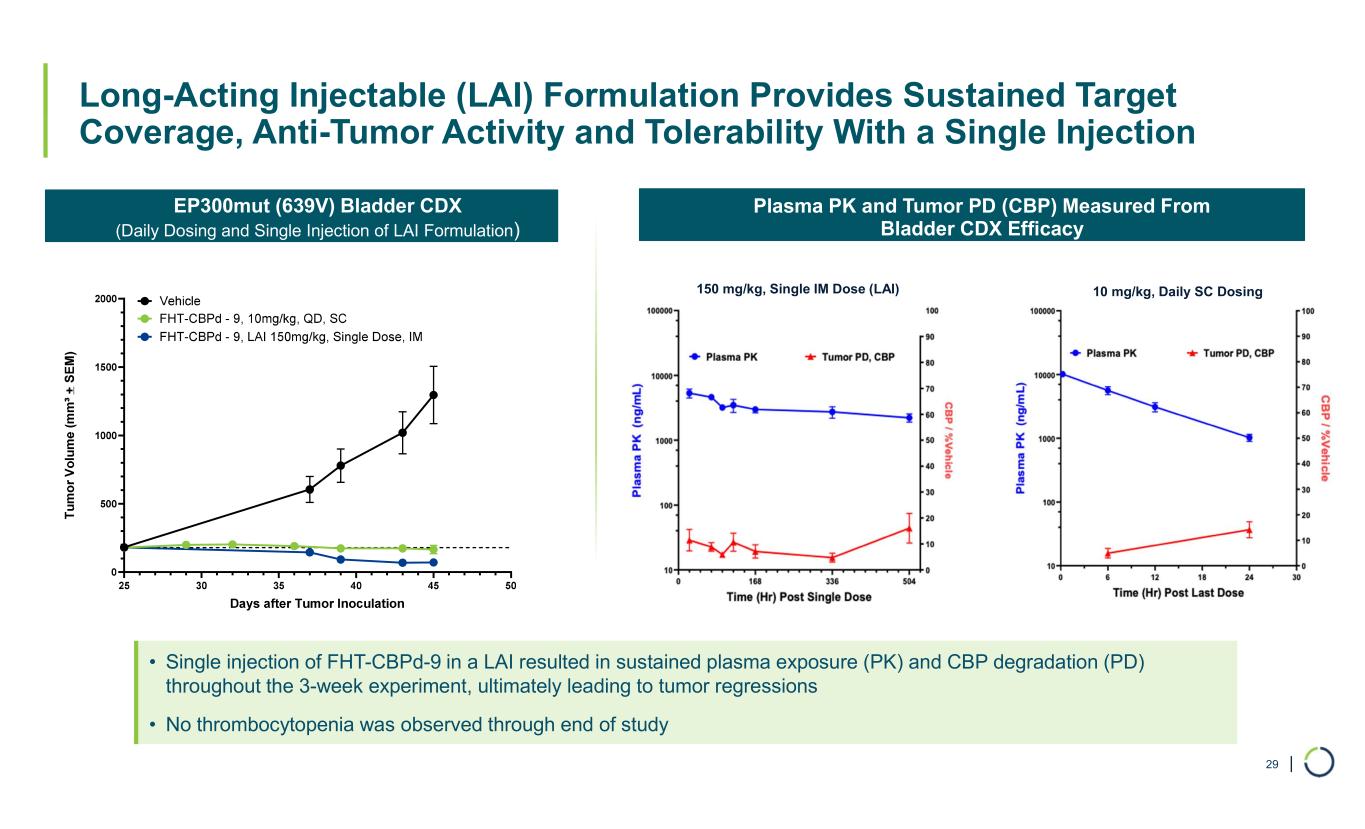
| EP300mut (639V) Bladder CDX (Daily Dosing and Single Injection of LAI Formulation) Plasma PK and Tumor PD (CBP) Measured From Bladder CDX Efficacy • Single injection of FHT-CBPd-9 in a LAI resulted in sustained plasma exposure (PK) and CBP degradation (PD) throughout the 3-week experiment, ultimately leading to tumor regressions • No thrombocytopenia was observed through end of study 150 mg/kg, Single IM Dose (LAI) 10 mg/kg, Daily SC Dosing Long-Acting Injectable (LAI) Formulation Provides Sustained Target Coverage, Anti-Tumor Activity and Tolerability With a Single Injection 29
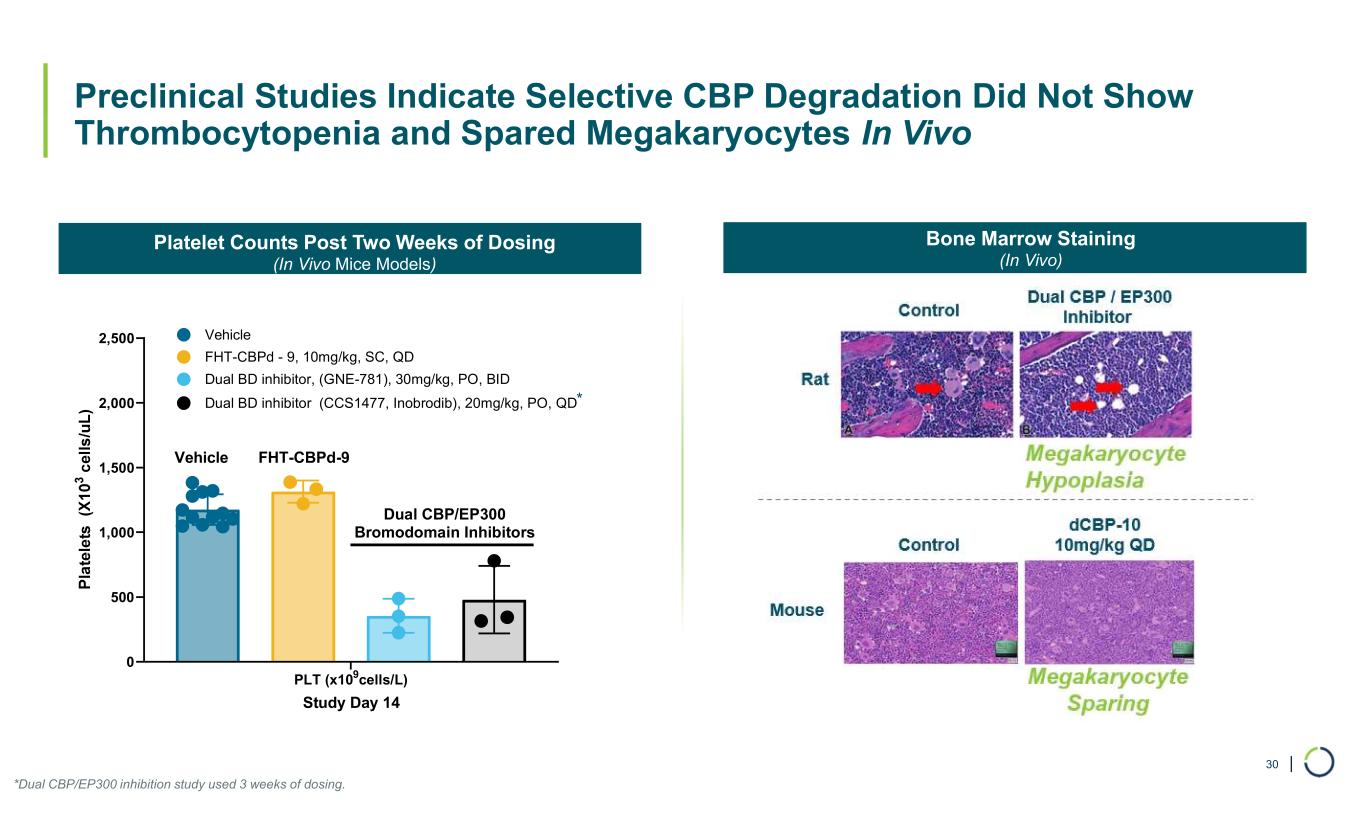
| Bone Marrow Staining (In Vivo) Platelet Counts Post Two Weeks of Dosing (In Vivo Mice Models) *Dual CBP/EP300 inhibition study used 3 weeks of dosing. Preclinical Studies Indicate Selective CBP Degradation Did Not Show Thrombocytopenia and Spared Megakaryocytes In Vivo 30 PLT (x109cells/L) 0 500 1,000 1,500 2,000 2,500 Study Day 14 Vehicle FHT-CBPd - 9, 10mg/kg, SC, QD Dual BD inhibitor, (GNE-781), 30mg/kg, PO, BID FHT-CBPd-9 Dual CBP/EP300 Bromodomain Inhibitors Vehicle Dual BD inhibitor (CCS1477, Inobrodib), 20mg/kg, PO, QD*
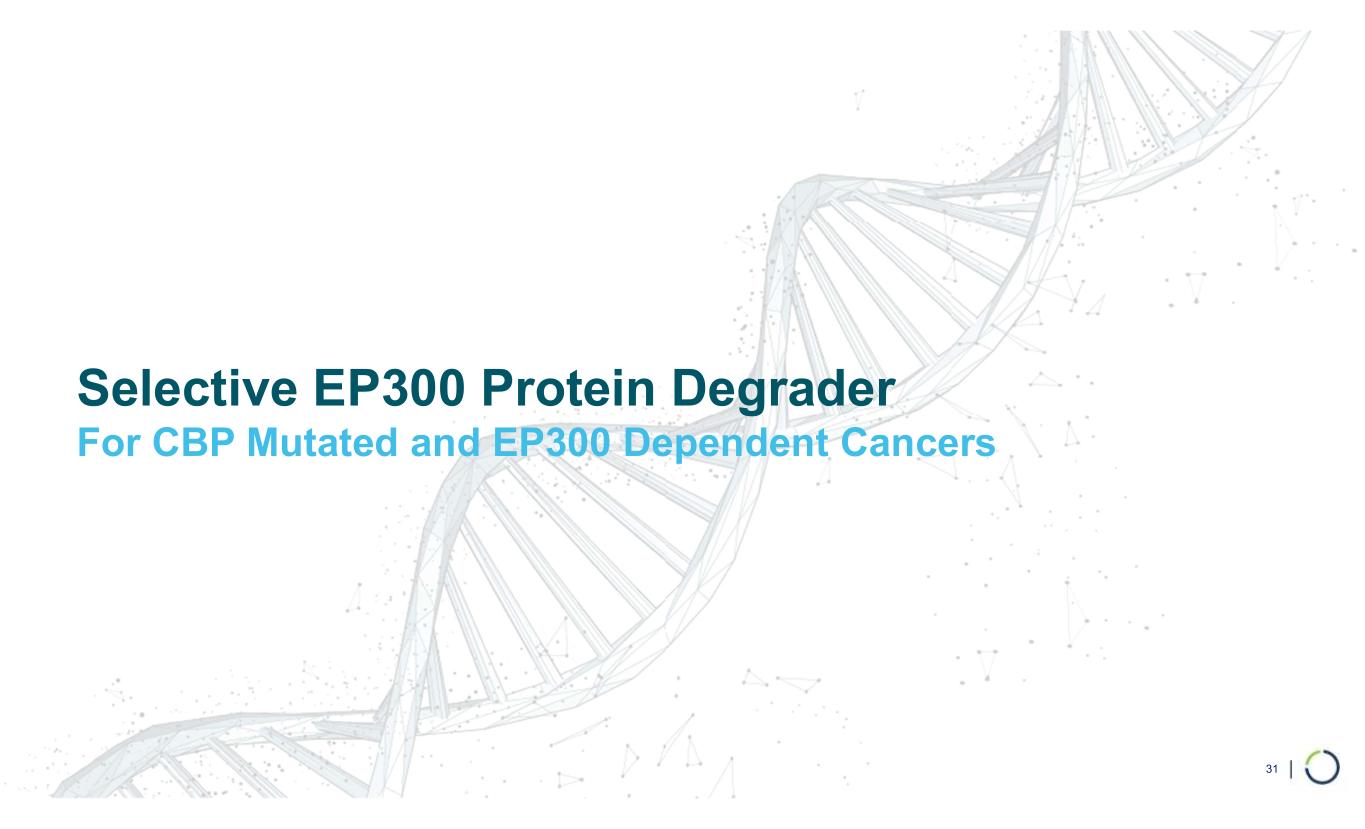
Selective EP300 Protein Degrader For CBP Mutated and EP300 Dependent Cancers 31
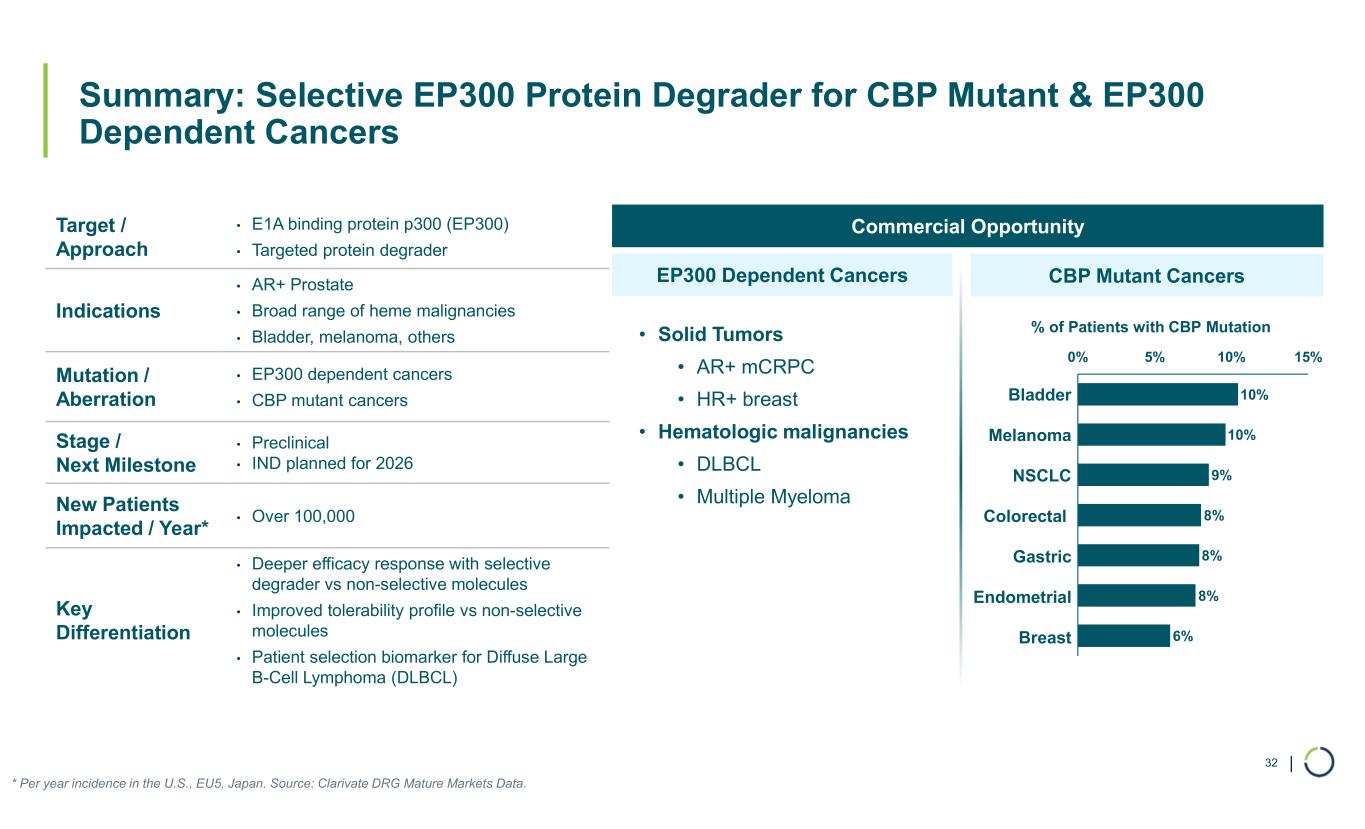
| Summary: Selective EP300 Protein Degrader for CBP Mutant & EP300 Dependent Cancers 32 * Per year incidence in the U.S., EU5, Japan. Source: Clarivate DRG Mature Markets Data. • E1A binding protein p300 (EP300) • Targeted protein degrader Target / Approach • AR+ Prostate • Broad range of heme malignancies • Bladder, melanoma, others Indications • EP300 dependent cancers • CBP mutant cancers Mutation / Aberration • Preclinical • IND planned for 2026 Stage / Next Milestone • Over 100,000 New Patients Impacted / Year* • Deeper efficacy response with selective degrader vs non-selective molecules • Improved tolerability profile vs non-selective molecules • Patient selection biomarker for Diffuse Large B-Cell Lymphoma (DLBCL) Key Differentiation Commercial Opportunity EP300 Dependent Cancers • Solid Tumors • AR+ mCRPC • HR+ breast • Hematologic malignancies • DLBCL • Multiple Myeloma CBP Mutant Cancers 10% 10% 9% 8% 8% 8% 6% 0% 5% 10% 15% Melanoma Bladder NSCLC Endometrial Colorectal Gastric Breast % of Patients with CBP Mutation
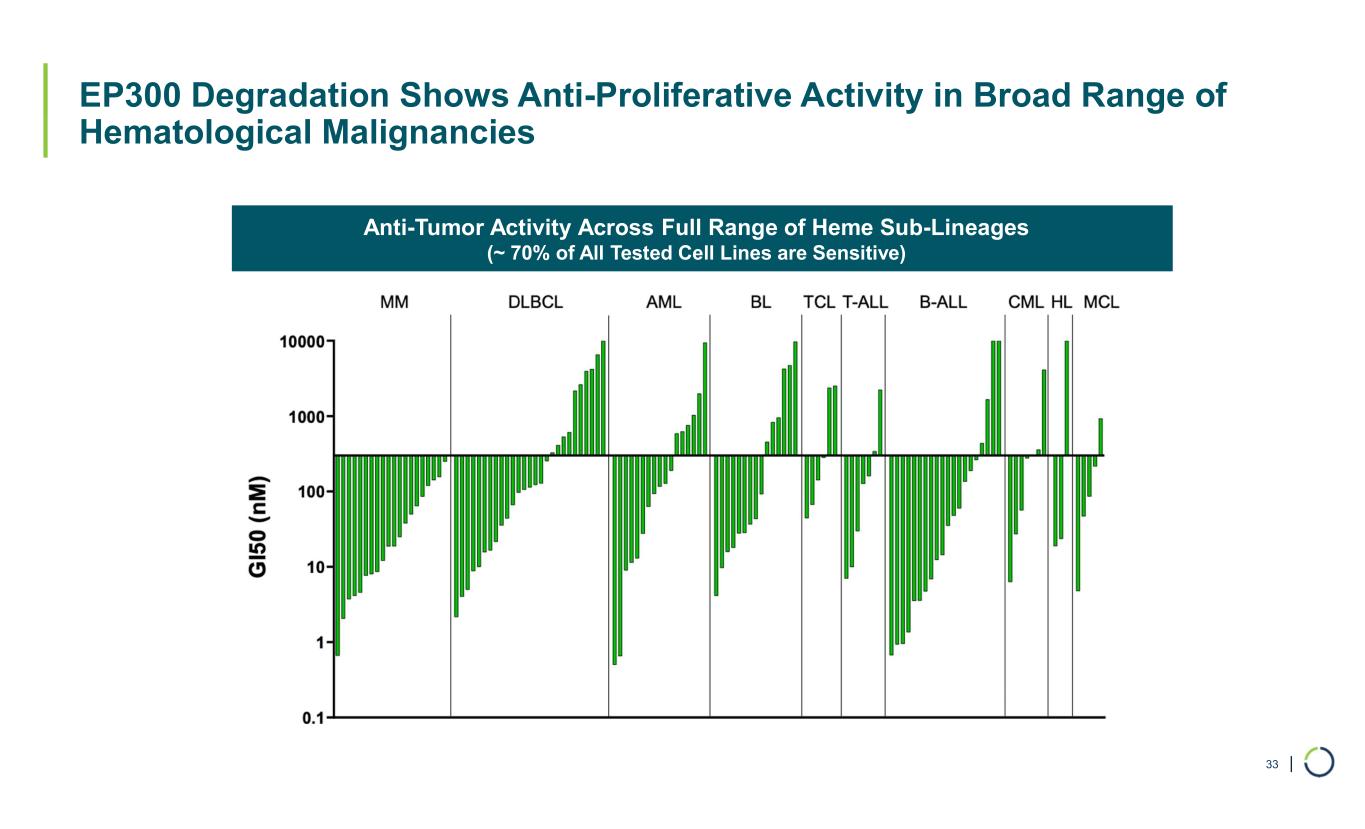
| Anti-Tumor Activity Across Full Range of Heme Sub-Lineages (~ 70% of All Tested Cell Lines are Sensitive) EP300 Degradation Shows Anti-Proliferative Activity in Broad Range of Hematological Malignancies 33
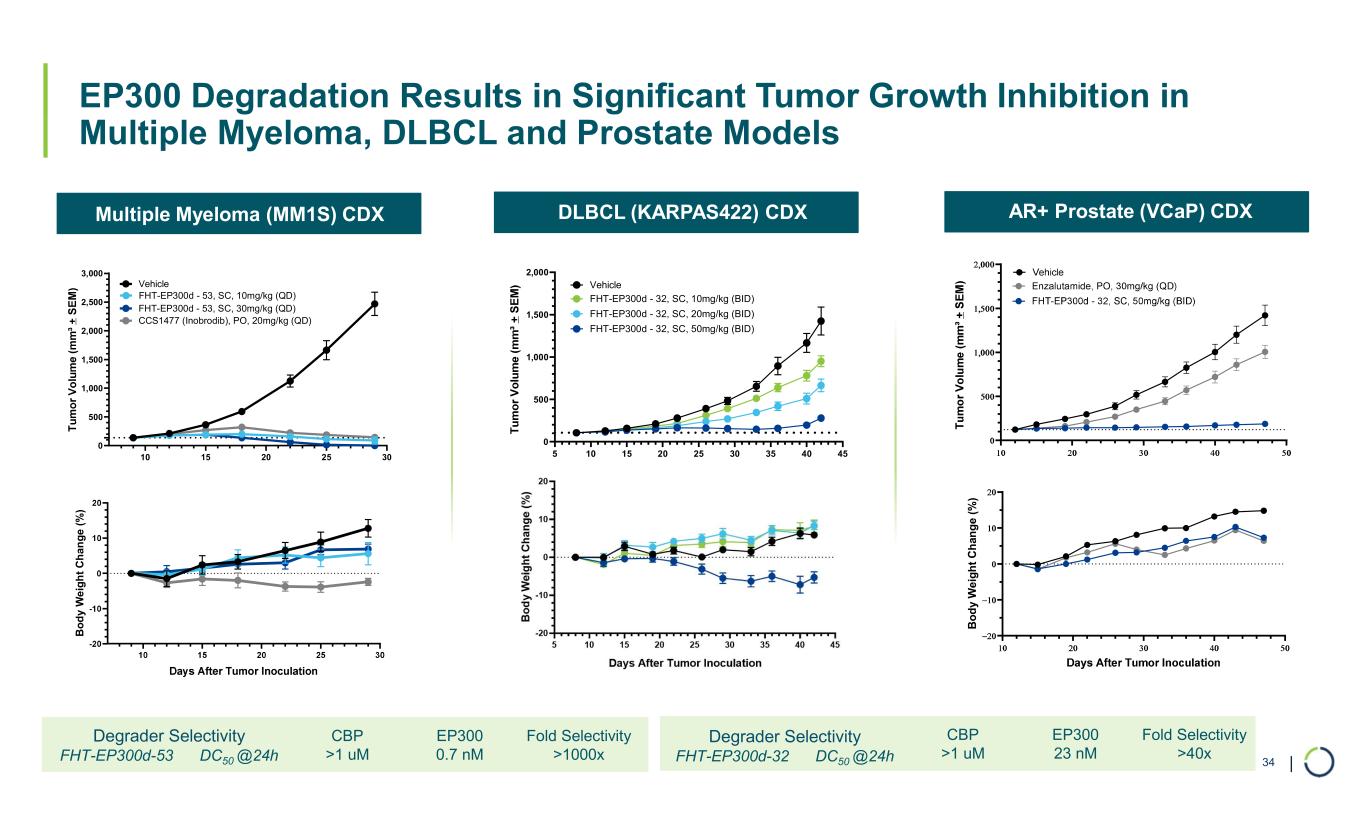
| Multiple Myeloma (MM1S) CDX DLBCL (KARPAS422) CDX AR+ Prostate (VCaP) CDX EP300 Degradation Results in Significant Tumor Growth Inhibition in Multiple Myeloma, DLBCL and Prostate Models 34 B o d y W ei g h t C h an g e (% ) 5 10 15 20 25 30 35 40 45 0 500 1,000 1,500 2,000 Vehicle FHT-EP300d - 32, SC, 50mg/kg (BID) Days After Tumor Inoculation FHT-EP300d - 32, SC, 20mg/kg (BID) FHT-EP300d - 32, SC, 10mg/kg (BID) B o d y W e ig h t C h an g e ( % ) 10 15 20 25 30 0 500 1,000 1,500 2,000 2,500 3,000 Days After Tumor Inoculation Vehicle FHT-EP300d - 53, SC, 30mg/kg (QD) FHT-EP300d - 53, SC, 10mg/kg (QD) CCS1477 (Inobrodib), PO, 20mg/kg (QD) Fold Selectivity >1000x EP300 0.7 nM CBP >1 uM Degrader Selectivity FHT-EP300d-53 DC50 @24h Fold Selectivity >40x EP300 23 nM CBP >1 uM Degrader Selectivity FHT-EP300d-32 DC50 @24h
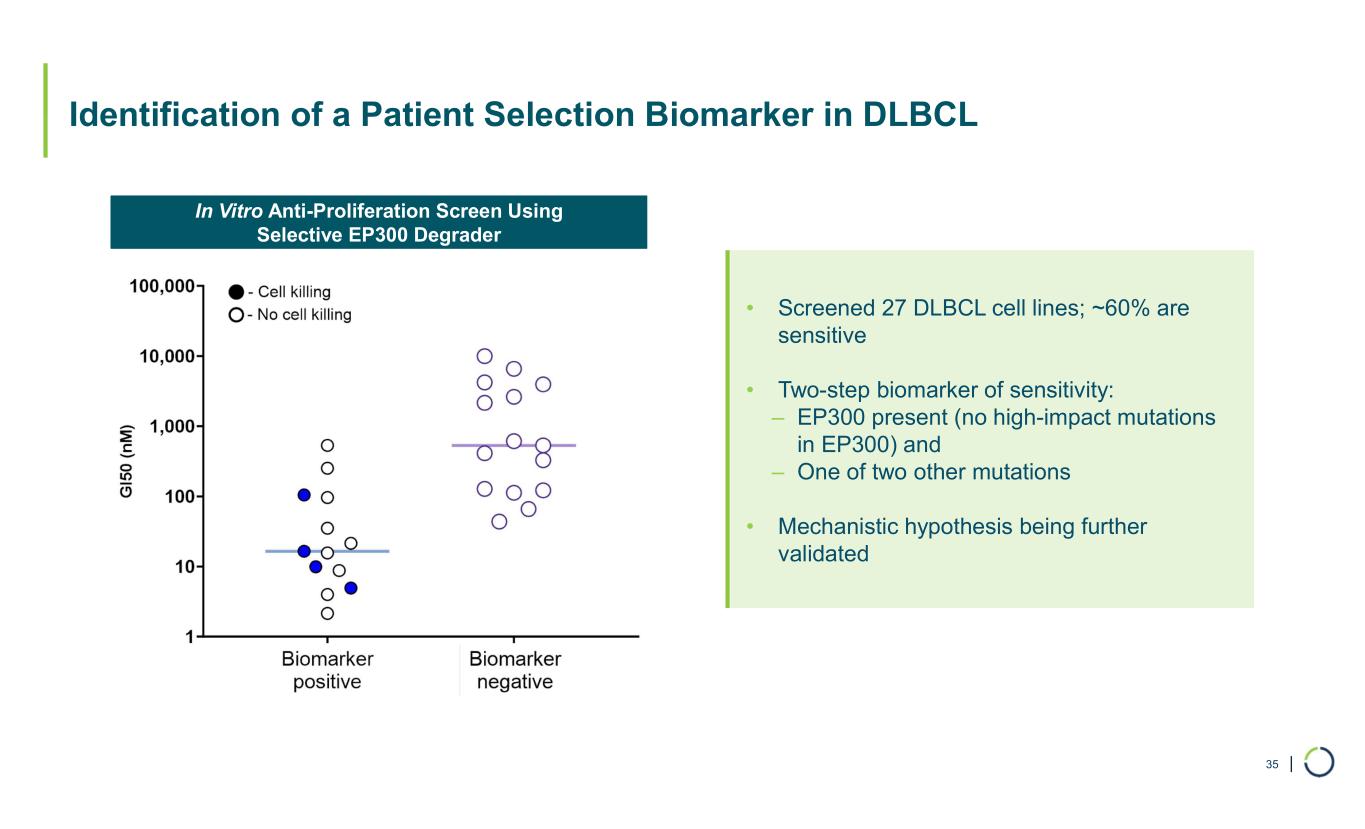
| Identification of a Patient Selection Biomarker in DLBCL • Screened 27 DLBCL cell lines; ~60% are sensitive • Two-step biomarker of sensitivity: ‒ EP300 present (no high-impact mutations in EP300) and ‒ One of two other mutations • Mechanistic hypothesis being further validated In Vitro Anti-Proliferation Screen Using Selective EP300 Degrader 35

| • Non-selective dual CBP/EP300 inhibitor shows tumor stasis, but clinical safety (i.e., thrombocytopenia) resulted in dosing holidays • Selective EP300 degrader can achieve deeper responses (complete tumor regression) with no thrombocytopenia • Selective EP300 degrader with improved therapeutic window enables sustained target coverage and improved efficacy Multiple Myeloma CDX treated w/ dEP300 - VHL Multiple Myeloma CDX treated w/ dEP300 - HL Selective EP300 Degrader Demonstrated Complete Response (Tumor Regression) in Multiple Myeloma Model 36 10 15 20 25 30 0 500 1,000 1,500 2,000 2,500 3,000 Days After Tumor Inoculation Vehicle FHT-EP300d - 53, SC, 30mg/kg (QD) FHT-EP300d - 53, SC, 10mg/kg (QD) CCS1477 (Inobrodib), PO, 20mg/kg (QD) B o d y W ei g h t C h an g e ( % ) 10 15 20 25 30 0 50 100 150 200 250 300 350 400 Days After Tumor Inoculation Multiple Myeloma CDX Treated With dEP300 – VHL

| Multiple Myeloma CDX treated w/ dEP300 - CRBN dEP300-CRBN demonstrates 32% oral bioavailability Multiple Myeloma CDX treated w/ dEP300 - CRBN Multiple Myeloma CDX treated w/ dEP300 - CRBN Oral EP300 Selective Degrader Shows Promising Efficacy; Well Tolerated With No Thrombocytopenia 37 CCS1477 Inobrodib dEP300-CRBN, p.o. Vehicle, p.o Multiple Myeloma CDX Treated With dEP300 – CRBN Fold Selectivity 250x EP300 0.2 nM CBP 50 nM Degrader Selectivity FHT-EP300d-CRBN DC50 @24h
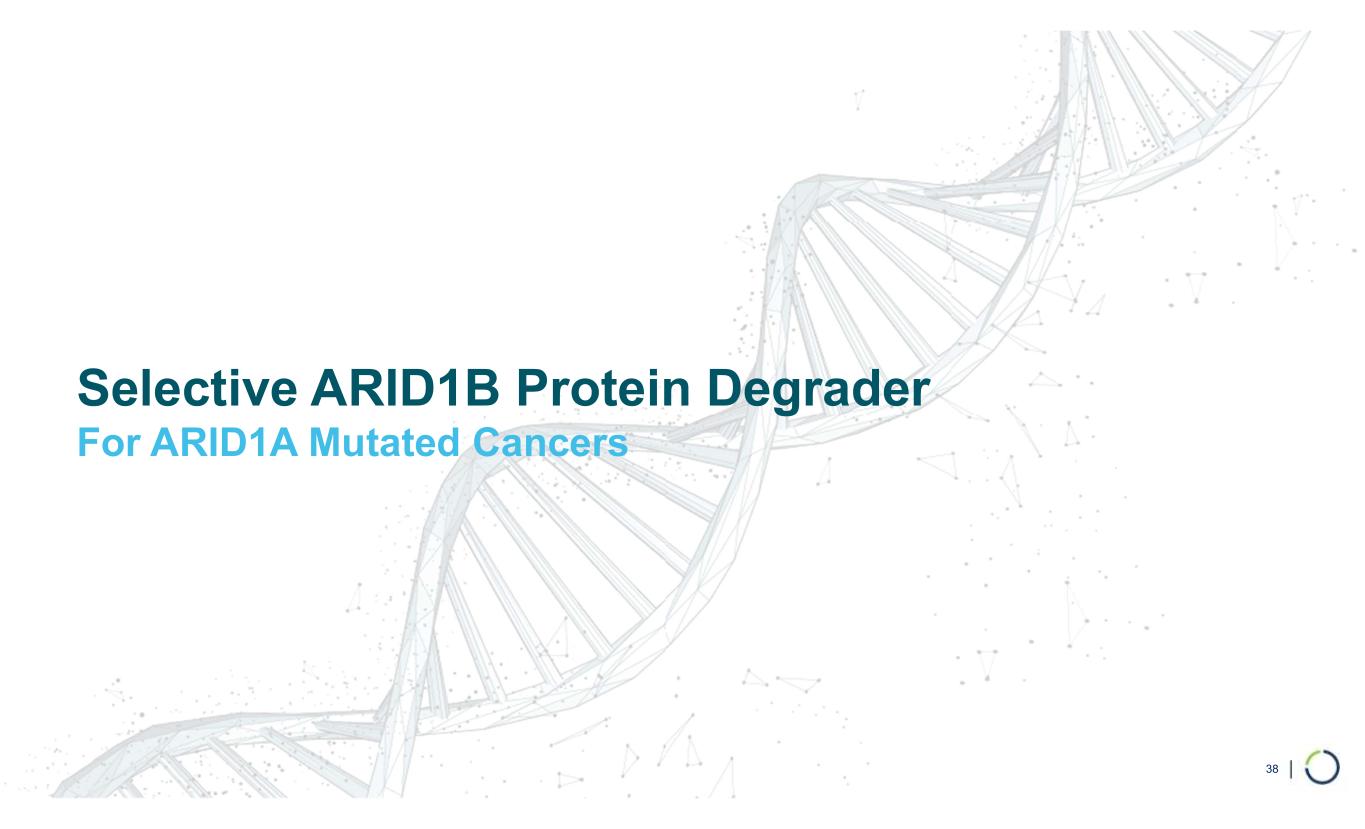
Selective ARID1B Protein Degrader For ARID1A Mutated Cancers 38
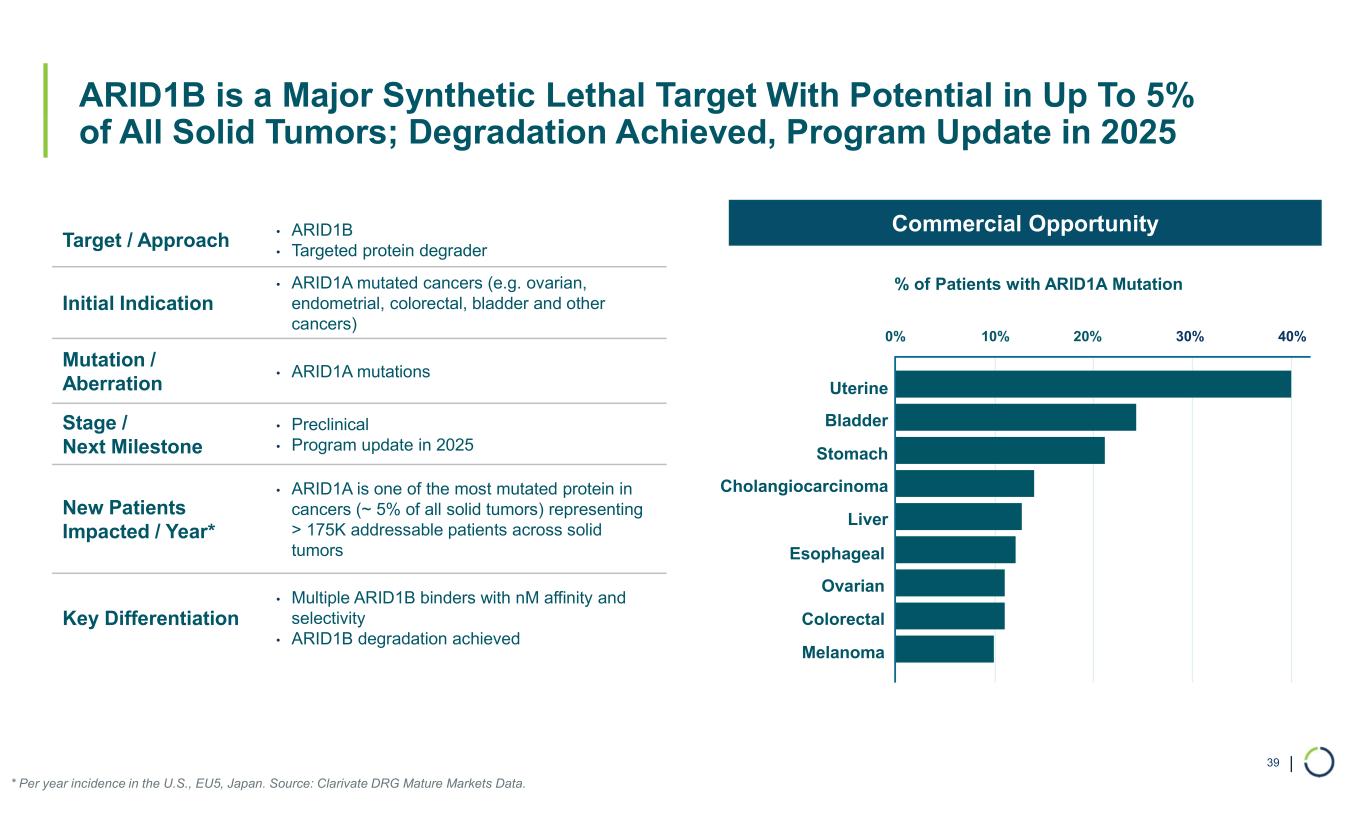
| ARID1B is a Major Synthetic Lethal Target With Potential in Up To 5% of All Solid Tumors; Degradation Achieved, Program Update in 2025 39 * Per year incidence in the U.S., EU5, Japan. Source: Clarivate DRG Mature Markets Data. • ARID1B • Targeted protein degraderTarget / Approach • ARID1A mutated cancers (e.g. ovarian, endometrial, colorectal, bladder and other cancers) Initial Indication • ARID1A mutations Mutation / Aberration • Preclinical • Program update in 2025 Stage / Next Milestone • ARID1A is one of the most mutated protein in cancers (~ 5% of all solid tumors) representing > 175K addressable patients across solid tumors New Patients Impacted / Year* • Multiple ARID1B binders with nM affinity and selectivity • ARID1B degradation achieved Key Differentiation Uterine Bladder Stomach Cholangiocarcinoma Liver Esophageal Ovarian Colorectal Melanoma 0% 10% 20% 30% 40% Commercial Opportunity % of Patients with ARID1A Mutation
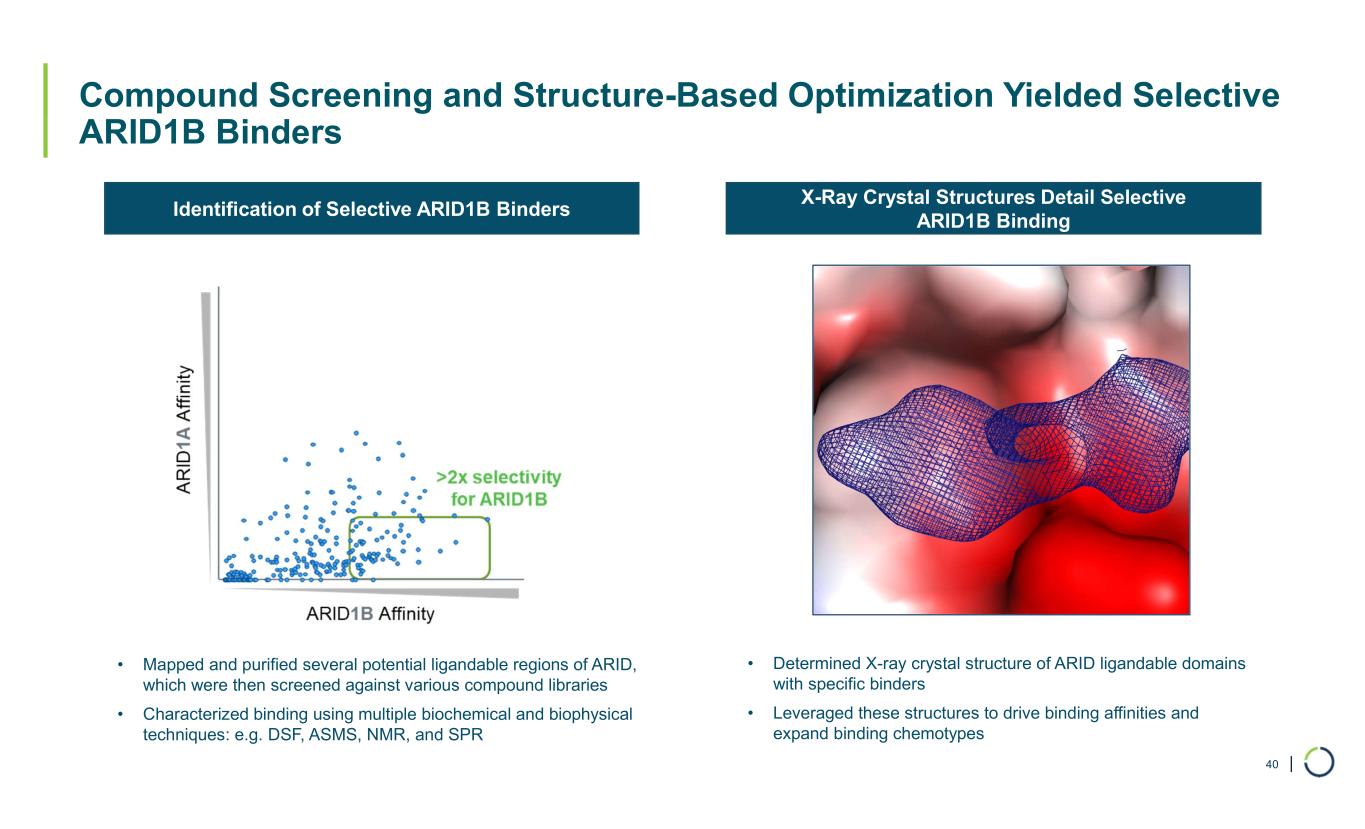
| Compound Screening and Structure-Based Optimization Yielded Selective ARID1B Binders 40 • Mapped and purified several potential ligandable regions of ARID, which were then screened against various compound libraries • Characterized binding using multiple biochemical and biophysical techniques: e.g. DSF, ASMS, NMR, and SPR • Determined X-ray crystal structure of ARID ligandable domains with specific binders • Leveraged these structures to drive binding affinities and expand binding chemotypes Identification of Selective ARID1B Binders X-Ray Crystal Structures Detail Selective ARID1B Binding
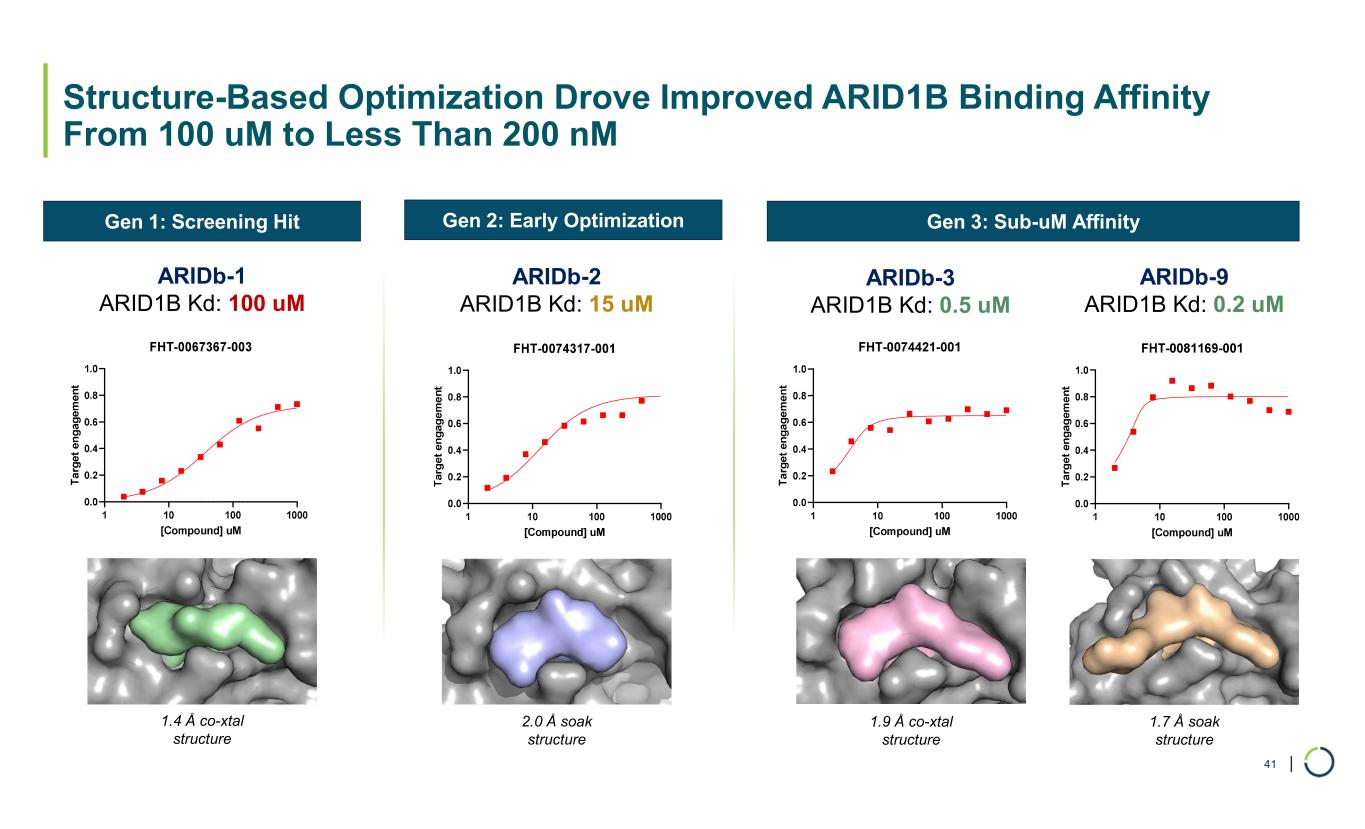
| Structure-Based Optimization Drove Improved ARID1B Binding Affinity From 100 uM to Less Than 200 nM 41 1.4 Å co-xtal structure 2.0 Å soak structure 1.7 Å soak structure ARIDb-2 ARID1B Kd: 15 uM ARIDb-1 ARID1B Kd: 100 uM ARIDb-3 ARID1B Kd: 0.5 uM ARIDb-9 ARID1B Kd: 0.2 uM 1.9 Å co-xtal structure Gen 1: Screening Hit Gen 2: Early Optimization Gen 3: Sub-uM Affinity
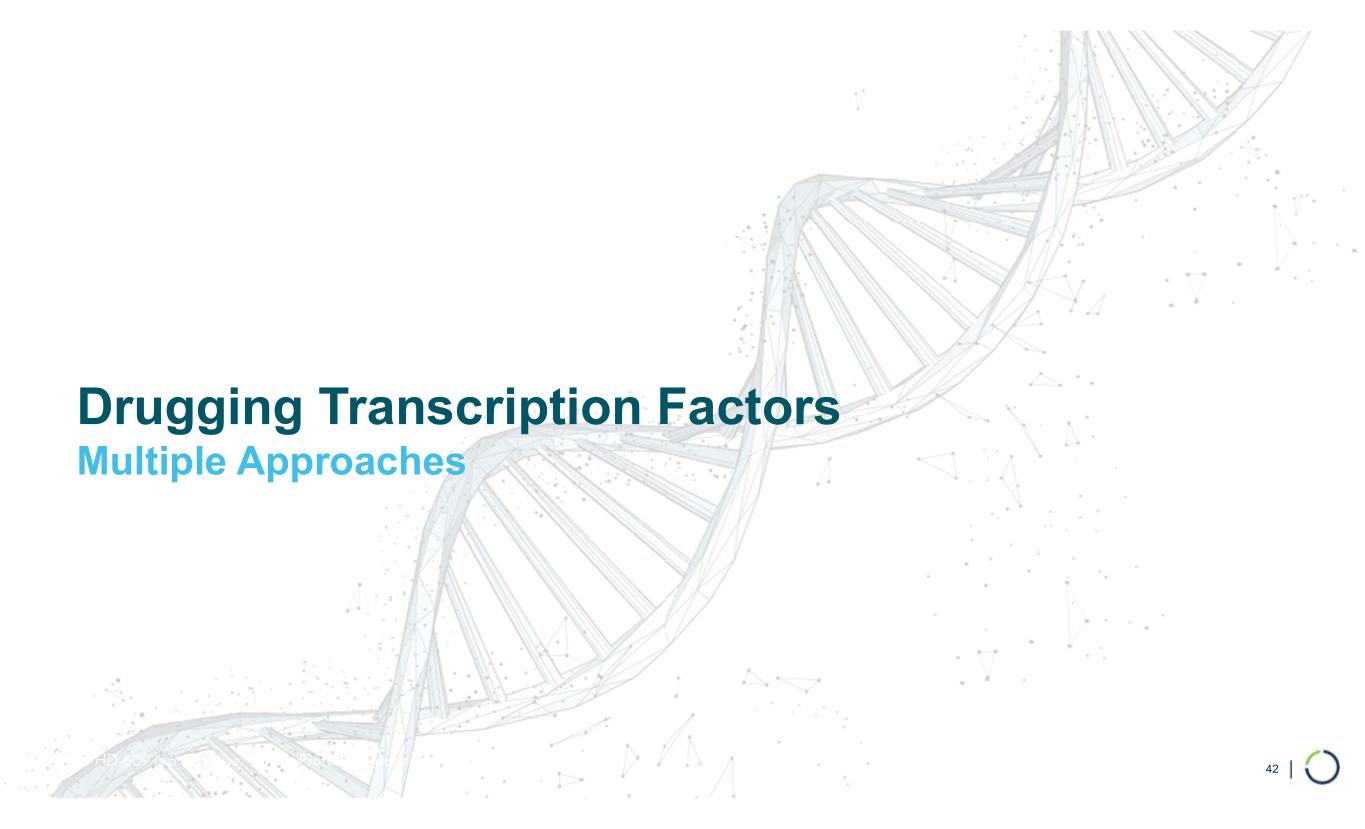
Drugging Transcription Factors Multiple Approaches FHD-609 is a Selective, Potent, Protein Degrader of the BRD9 component of the BAF complex 42

| Foghorn’s Transcription Factor Platform: 4 Approaches 43 Transcription Factor Chromatin Remodeler Modulating TF activity via Protein-Protein Interaction Disruptors Transcription Factor Native E3 Ligase Degrading TFs via recruitment of the native E3 ligase using molecular glue = MG (Molecular Glue) Leveraging Phenotypic Screening to reduce TF levels in disease relevant settings Re-wiring transcription through Induced Proximity with TFs Disease relevant cell lines (change image – copyright?) Transcription Factor Activator/ Repressor = CIP (Chemical Inducer of Proximity) CIP MG Transcription Factor
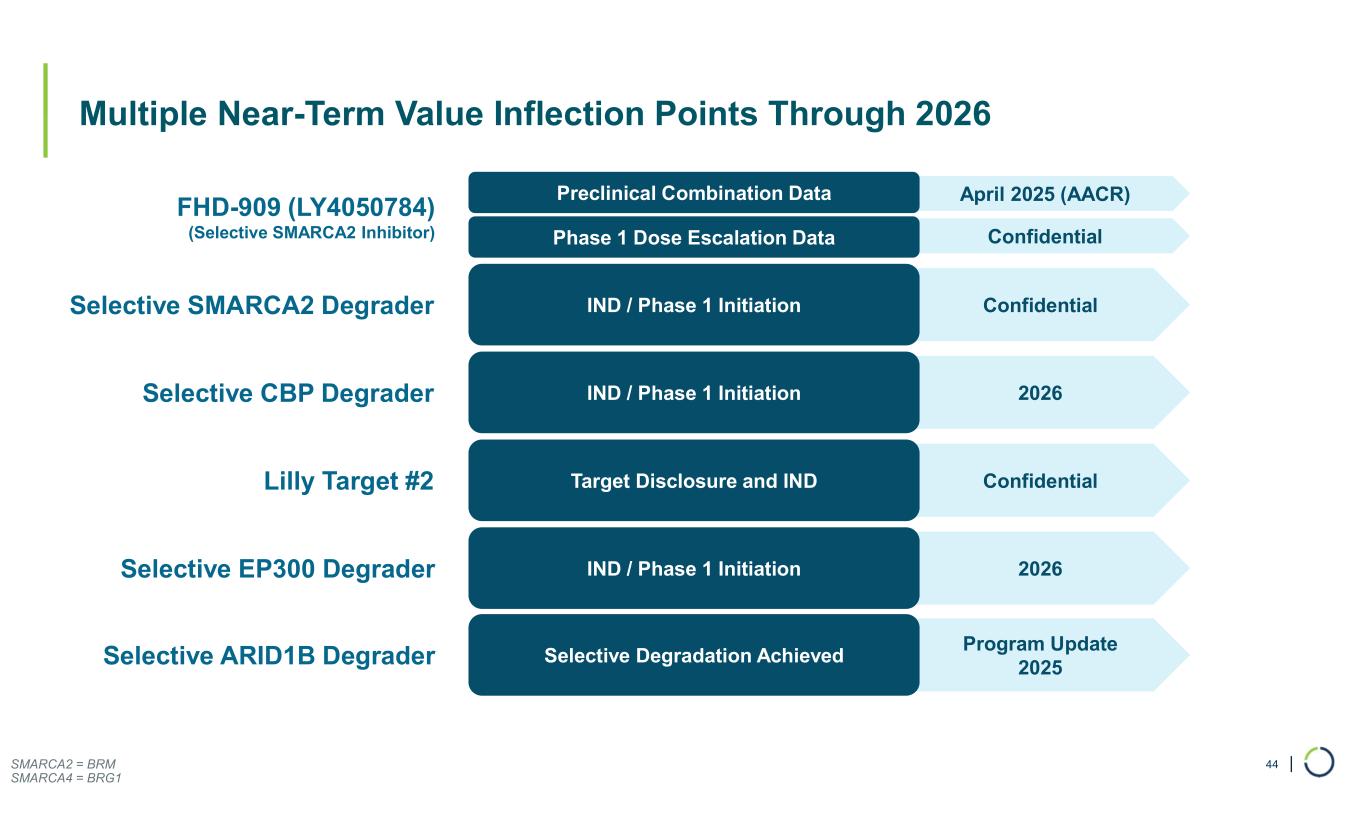
| Multiple Near-Term Value Inflection Points Through 2026 44 April 2025 (AACR)Preclinical Combination Data FHD-909 (LY4050784) (Selective SMARCA2 Inhibitor) ConfidentialIND / Phase 1 InitiationSelective SMARCA2 Degrader 2026IND / Phase 1 InitiationSelective CBP Degrader 2026IND / Phase 1 InitiationSelective EP300 Degrader ConfidentialTarget Disclosure and INDLilly Target #2 Program Update 2025 Selective Degradation AchievedSelective ARID1B Degrader SMARCA2 = BRM SMARCA4 = BRG1 ConfidentialPhase 1 Dose Escalation Data

| Developing First-in-Class Precision Medicines Targeting Major Unmet Needs in Cancer 45 Large Market Potential Chromatin biology is implicated in up to 50% of tumors, potentially impacting ~2.5 million patients Foghorn’s current pipeline potentially addresses more than 500,000 of these patients Broad pipeline across a range of targets and small molecule modalities Major Strategic Collaboration Strategic collaboration with Lilly; $380 million upfront; 50/50 U.S. economic split on two lead programs Well- Funded $243.8 million in cash and equivalents (unaudited) (as of 12/31/2024) Cash runway into 2027 Shares outstanding: approximately 62.5M* Value Drivers Selective SMARCA2 Inhibitor, FHD-909, partnered with Lilly, in Phase 1 trial Advancement of preclinical assets (Selective SMARCA2 Degrader, CBP, EP300, ARID1B) towards INDs Protein degrader platform with expansion into induced proximity Leader in Unique Area of Cancer Biology Foghorn is a leader in targeting chromatin biology, which has the potential to address underlying dependencies of many genetically defined cancers Platform with initial focus in oncology, therapeutic area expansion potential *Includes common shares outstanding and pre-funded warrants as of 12/31/2024.
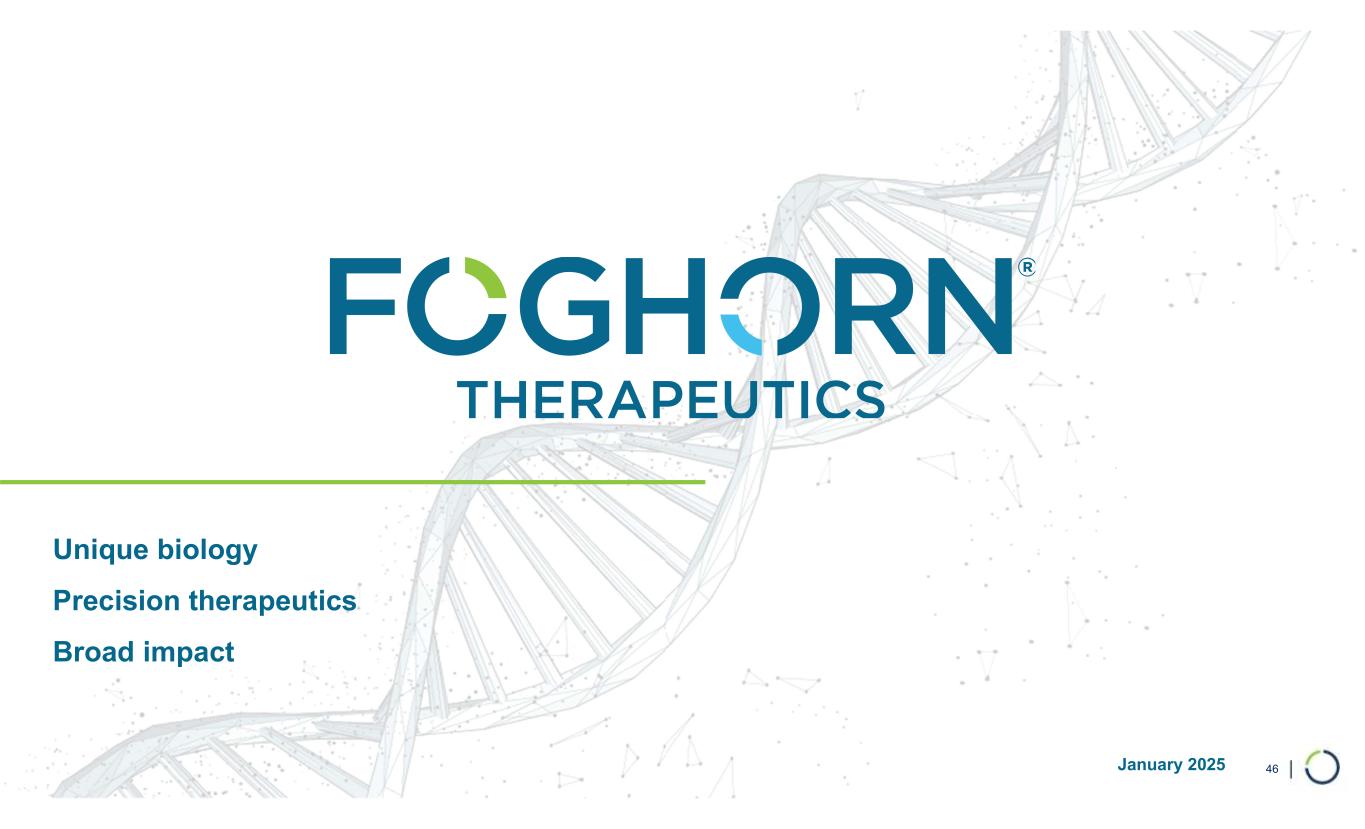
Unique biology Precision therapeutics Broad impact 46January 2025
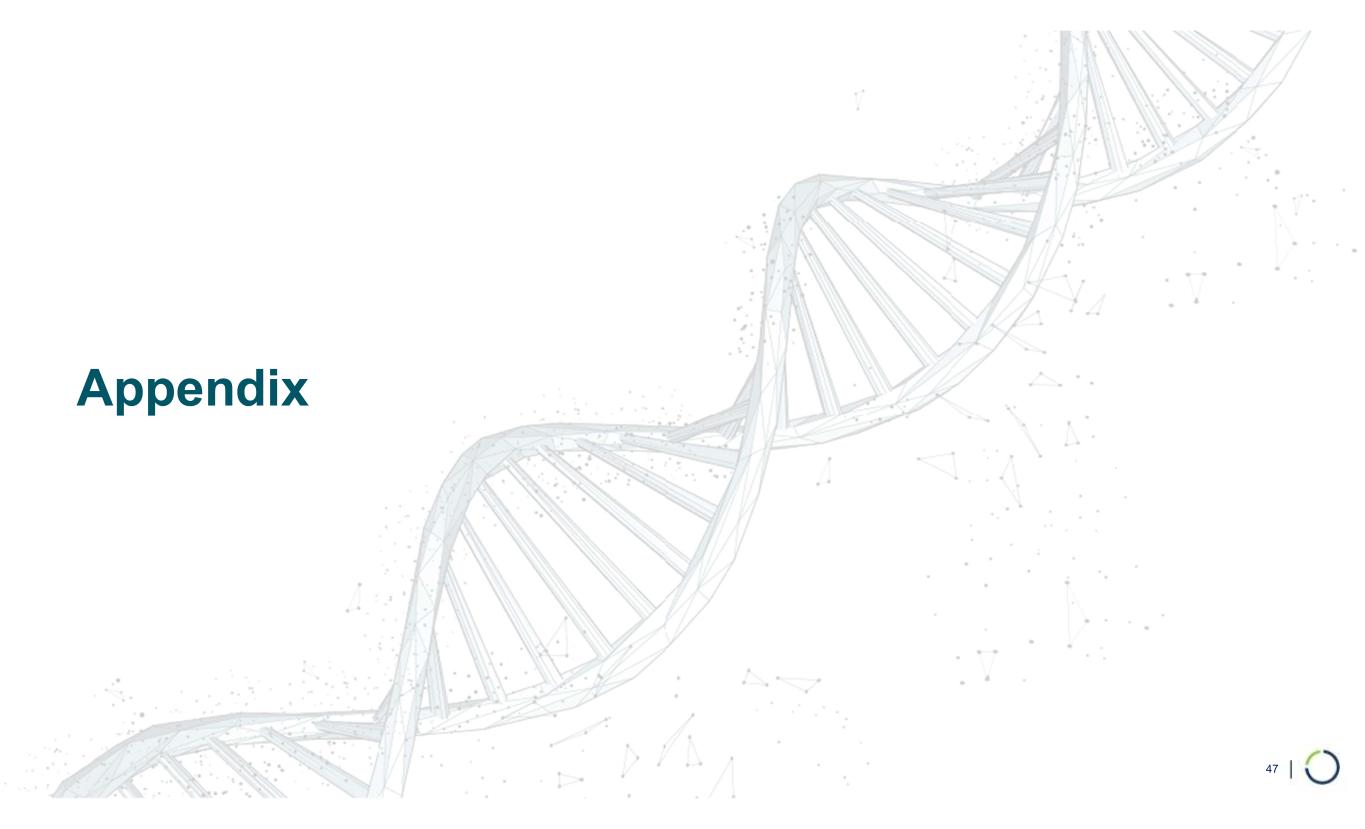
Appendix 47
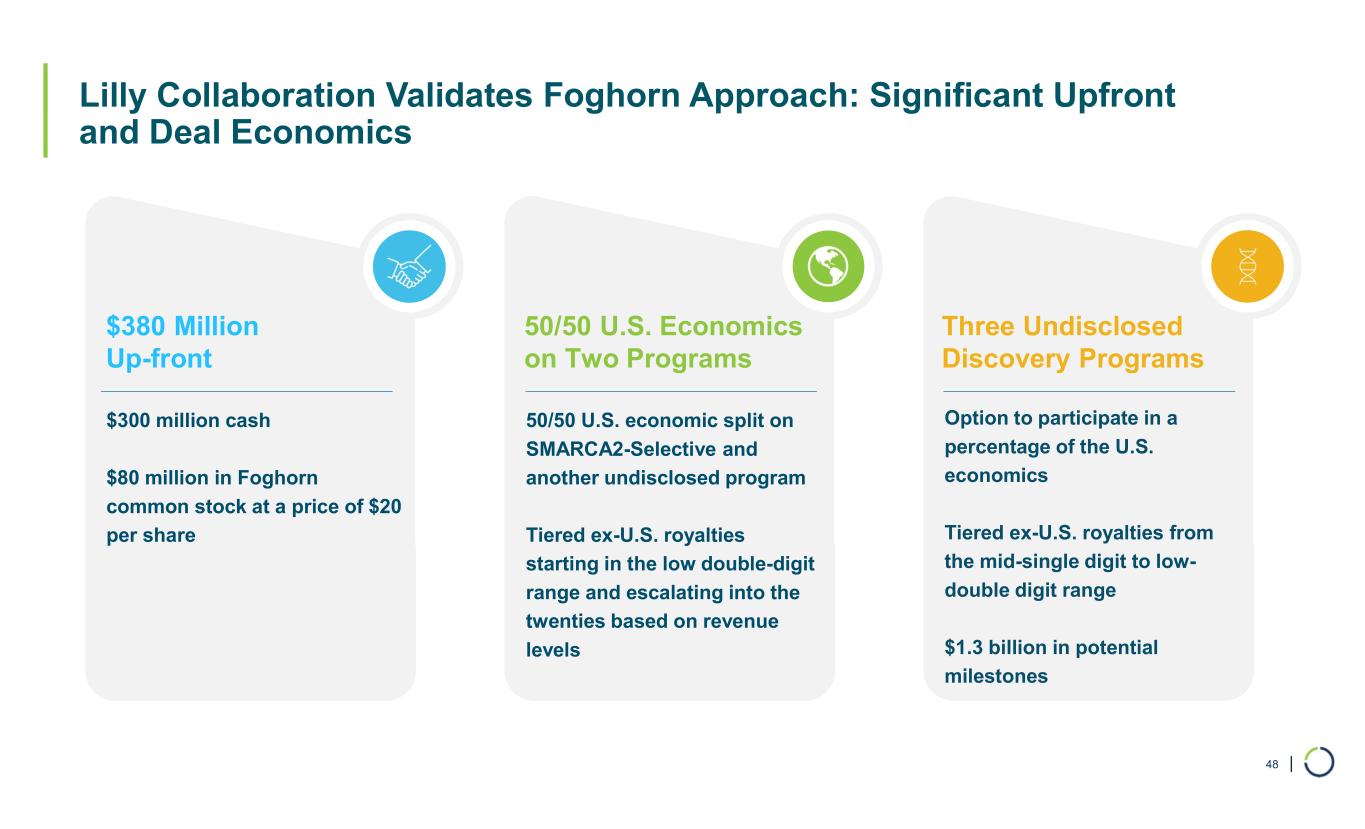
| Lilly Collaboration Validates Foghorn Approach: Significant Upfront and Deal Economics 48 $380 Million Up-front $300 million cash $80 million in Foghorn common stock at a price of $20 per share Three Undisclosed Discovery Programs Option to participate in a percentage of the U.S. economics Tiered ex-U.S. royalties from the mid-single digit to low- double digit range $1.3 billion in potential milestones 50/50 U.S. Economics on Two Programs 50/50 U.S. economic split on SMARCA2-Selective and another undisclosed program Tiered ex-U.S. royalties starting in the low double-digit range and escalating into the twenties based on revenue levels















































